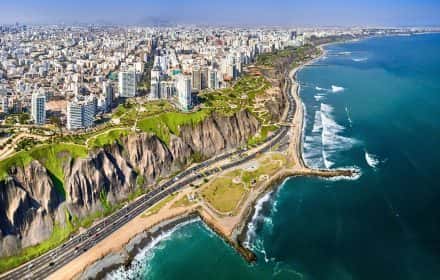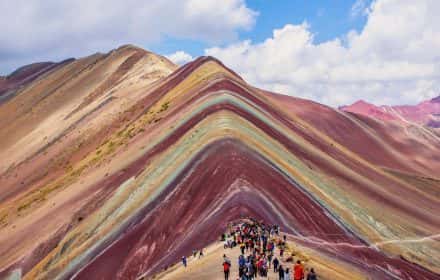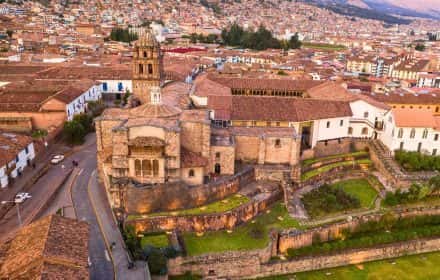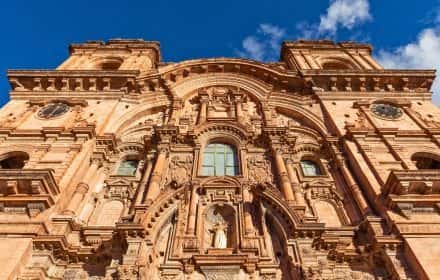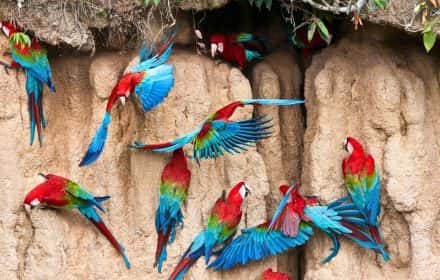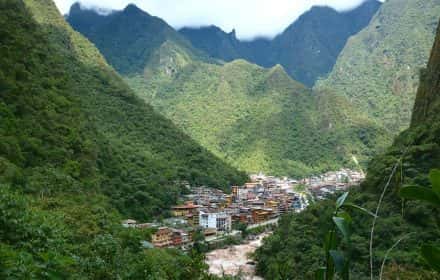This site uses affiliate links, meaning that if you make a purchase through our links, we may earn an affiliate commission.
Embark on an unforgettable adventure through Peru, a country teeming with awe-inspiring landscapes, ancient ruins, and vibrant culture!
During these 12 days in Peru, you will delve deep into the heart of the Amazon rainforest, stand in awe of the enigmatic ruins of Machu Picchu, immerse yourself in the bustling cities of Lima and Cusco, and explore the captivating beauty of the Sacred Valley. Get ready to be amazed by Peru’s rich history, natural wonders, and warm hospitality as you embark on this remarkable journey.
- 1. Amazing 12 Days in Peru: Exploring the Best Peruvian Wonders
-
- 1.1. DAY 1 - Arrival in Cusco and Exploration of Cusco's Historic Gems
- 1.2. DAY 2 - Day Trip from Cusco to Sacsayhuaman, Qenko, Puka Pukara, Tambomachay, and Pisac
- 1.3. DAY 3 - Exploring the Marvels of the Sacred Valley: Maras, Moray, and Ollantaytambo
- 1.4. Day 4 - Day Trip from Cusco to Rainbow Mountain - Exploring the Vibrant Heights
- 1.5. Day 5 - Journey to Aguas Calientes: Gateway to Machu Picchu and Exploration of Aguas Calientes
- 1.6. Day 6 - Machu Picchu Exploration
- 1.7. Day 7 - Journey into Tambopata National Preserve: the Heart of Peruvian Amazon
- 1.8. Day 8 - Tambopata Rainforest Adventures - Macaw Clay Lick and Mammal Clay Lick Encounter
- 1.9. Day 9 - Tambopata Rainforest Adventures - Canopy Observation Tower and Journey to Lima
- 1.10. Day 10 - Lima's Exploration: Rich Heritage and Cultural Marvels
- 1.11. Day 11 - Day Trip from Lima to Lake Titicaca - The Islands of Uros and Taquile Island
- 1.12. Day 12 - Day Trip from Lima to the Nazca Lines, Chauchilla Cemetery, Antonini Archaeological Museum
- 2. Intrepid Scout's Tips for 12 Days in Peru Itinerary
Amazing 12 Days in Peru: Exploring the Best Peruvian Wonders
DAY 1 - Arrival in Cusco and Exploration of Cusco's Historic Gems
Arrival in Cusco
Cusco City Tour
- Plaza de Armas
- Coricancha (The Temple of the Sun)
- San Pedro Market
- 12-Angled Stone
Arrival in Cusco: How to Get Around and Where to Stay
- How to Get Around in Cusco
When it comes to exploring the captivating city of Cusco, knowing how to get around is key to making the most of your visit. From ancient ruins to bustling markets and picturesque neighborhoods, Cusco offers a plethora of sights and experiences just waiting to be discovered. To help you navigate this vibrant city with ease, we have put together a guide to assist you in getting around Cusco efficiently and conveniently.
Walking: Cusco’s compact city center makes it ideal for exploring on foot. Stroll through its narrow cobblestone streets, absorb the charming atmosphere, and discover hidden gems at your own pace. Walking is a great way to appreciate the city’s architecture, vibrant markets, and local culture up close.
Taxis: Taxis are readily available throughout Cusco, and they provide a convenient and flexible way to get around the city. You can easily flag down a taxi on the street or find them at designated taxi stands. It is advisable to negotiate the fare or ensure the meter is used before starting your journey.
Private Guide/Driver: Having a private driver and a guide is the best way to go. This option gives you total flexibility. Also, having a knowledgeable guide by your side is simply invaluable.
Tour: There are plenty of full-day or half-day tours that cover all the major attractions in Cusco. Check out this tour: Cusco City Sightseeing, San Pedro Market, Cathedral, and Qorikancha Temple
- Where to Stay in Cusco
When deciding on the ideal place to stay in the captivating Cusco, look no further than the vibrant district of San Blas. This bohemian neighborhood is a hidden gem that offers a unique and unforgettable experience for visitors seeking a blend of charm, culture, and convenience.
Here are some places, that I always enjoy staying in:
Antigua Casona San Blas is a charming boutique hotel in Cusco’s San Blas district, known for its warm hospitality and rich cultural experience. You can relax in the peaceful central courtyard, surrounded by lush greenery and a soothing fountain. The hotel also features an onsite restaurant, serving delectable dishes that showcase the flavors of Peruvian cuisine. From traditional Peruvian specialties to international favorites, the restaurant at Antigua Casona San Blas offers a delightful dining experience for guests. With its prime location in the vibrant San Blas neighborhood, you will have easy access to art galleries, handicraft markets, and delightful cafes.
Atoq San Blas Hotel is another one of my favorite spots. It is a charming boutique hotel located in Cusco’s San Blas district. With its cozy and inviting atmosphere, comfortable rooms, and rooftop terrace boasting panoramic views of the city, it offers a delightful stay if you are seeking a blend of comfort and cultural exploration. Situated amidst art galleries, craft shops, and quaint cafes, you can immerse yourself in the vibrant art scene of San Blas. The attentive staff is always ready to provide personalized service and recommendations for local attractions, ensuring a memorable experience in the heart of Cusco.
Quinta San Blas by Ananay Hotels is a luxurious boutique hotel located in the charming San Blas district of Cusco. With its elegant design, sophisticated rooms, and serene courtyard, it offers a haven of tranquility in the heart of the city. You can indulge in the finest amenities, savor delectable cuisine at the renowned restaurant, and explore the vibrant art scene and cultural attractions of San Blas.
Cusco City Tour: Plaza de Armas, Coricancha, San Pedro Market, 12-Angled Stone
Welcome to Cusco, the historic capital of the Incan Empire!
In this exhilarating exploration, you will immerse yourself in the enchanting Plaza de Armas, marvel at the architectural brilliance of Coricancha, delve into the vibrant local market, and uncover the captivating mystery of the 12-Angled Stone. Prepare to be captivated by the rich heritage, architectural marvels, and cultural tapestry that define this remarkable city.
Plaza de Armas
Nestled at the heart of Cusco, the Plaza de Armas stands as a testament to the city’s rich history and vibrant culture. Once known as Huacaypata, an esteemed ceremonial space for the Incas, it continues to be a lively gathering spot for locals and visitors alike. Surrounded by magnificent historical buildings, charming restaurants, and delightful shops, the Plaza captivates with its grandeur and charm.
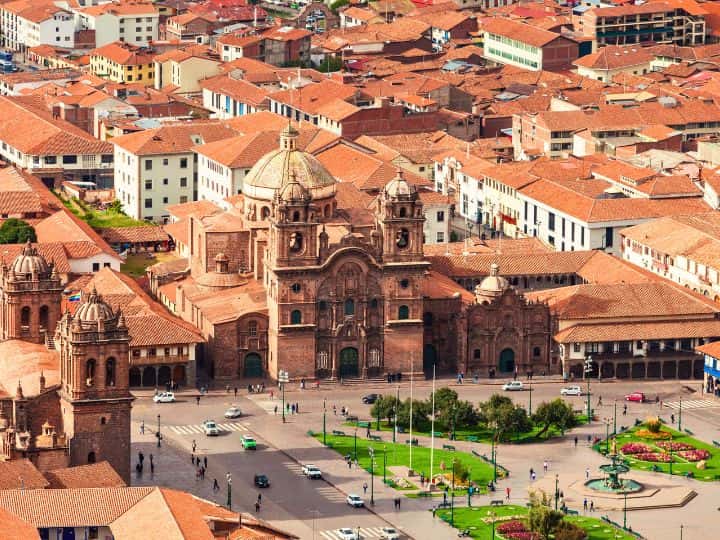
Plaza de Armas, Cusco / 12 Days in Peru Itinerary
This iconic square showcases a harmonious blend of Spanish colonial architecture, with its picturesque arcades framing the perimeter. It holds significant historical importance as a central hub in the Incan road network, connecting Cusco to far-reaching corners of the empire. The plaza’s legacy as a crossroads of ancient civilizations is embraced by the modern vibrancy it exudes today.
Overlooking the square, the Cathedral Basilica of the Assumption of the Virgin stands tall, a masterpiece of Renaissance, Gothic, and Baroque styles. Inside, the cathedral houses a breathtaking collection of colonial art, a testament to Cusco’s captivating cultural heritage.
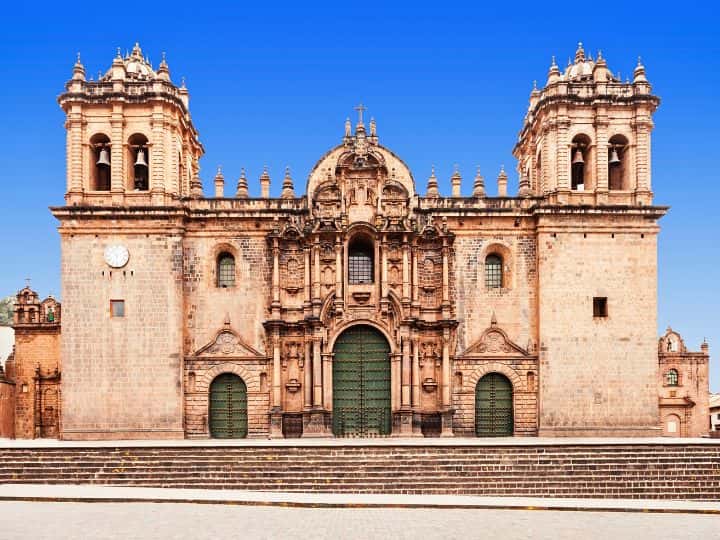
Cathedral Basilica of the Assumption of the Virgin, Cusco / 12 Days in Peru Itinerary
Adjacent to the cathedral, the Church of the Society of Jesus (Iglesia de la Compañía de Jesús) captivates with its ornate Baroque facade and exquisite altars, a celebration of artistry and devotion.
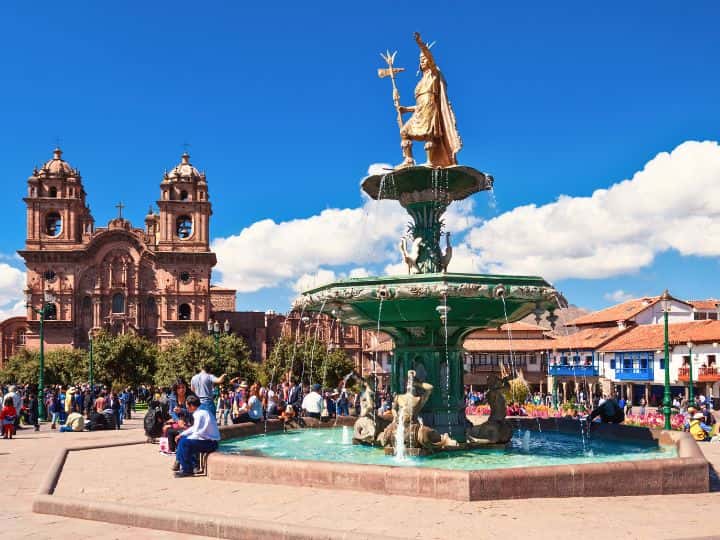
Iglesia de la Compañía de Jesús, Cusco / 12 Days in Peru Itinerary
Coricancha
Coricancha, also known as the Temple of the Sun, stands as a testament to the Incan Empire’s profound reverence for the celestial deity, Inti, the sun god. As the most sacred and revered temple in the Incan civilization, Coricancha held a position of utmost importance in the spiritual and cultural life of the empire.
The architectural splendor of Coricancha was awe-inspiring, with its walls once adorned in resplendent gold, a manifestation of the Incan civilization’s opulence and devotion. Inside, the temple housed an array of precious artifacts and statues, symbolizing the intrinsic connection between the sun, the Incan royalty, and the prosperity of the empire.
The arrival of the Spanish conquistadors in the 16th century marked a turning point in the temple’s history. In an effort to suppress indigenous religious practices, the Spanish forcibly converted Coricancha into a church, renaming it Santo Domingo.
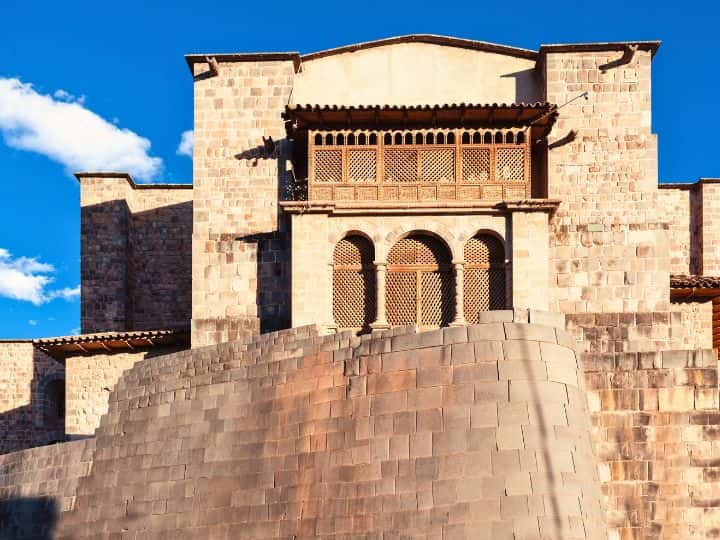
Cornicancha (Temple of the Sun) / 12 Days in Peru Itinerary
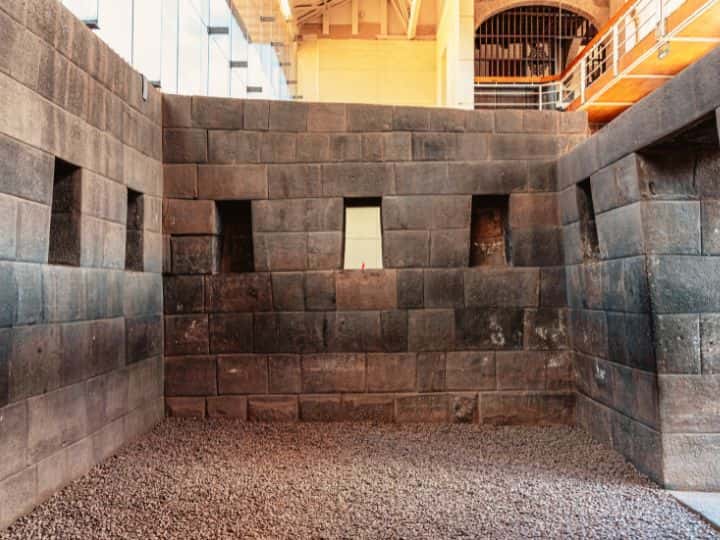
Cornicancha (Temple of the Sun) / 12 Days in Peru Itinerary
The imposing Spanish colonial architecture mingled with the original Incan stonework, creating a distinctive blend of two cultures, a vivid testimony to the complexities of Peru’s colonial past. Despite the tragic partial destruction the temple endured due to earthquakes and looting over the centuries, Coricancha continues to exude an aura of spiritual significance and cultural heritage.
San Pedro Market Experience
San Pedro Market (Mercado de San Pedro) is a vibrant and bustling market that offers an authentic glimpse into the local culture and culinary delights of the region. Located just a few blocks away from the Plaza de Armas, this bustling market is a must-visit destination for both tourists and locals alike.
Indulge in an assortment of delicious Peruvian fruits, such as lucuma, chirimoya, and aguaymanto. Many vendors offer freshly squeezed fruit juices, perfect for a refreshing pick-me-up.
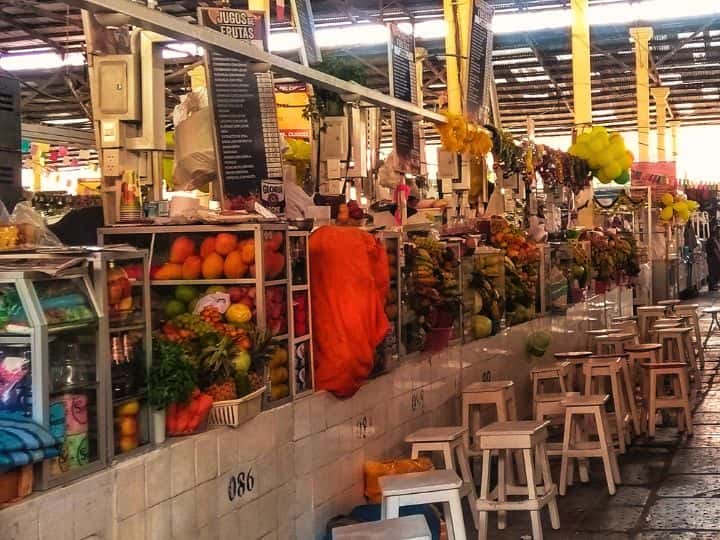
San Pedro Market in Cusco / 12 Days in Peru Itinerary
Try Anticuchos. These mouthwatering skewers are a Peruvian street food classic. They consist of marinated beef hearts or other meats, grilled to perfection and served with potatoes and a savory sauce.
Sample Peru’s famous ceviche, a dish made with fresh fish or seafood marinated in lime juice and mixed with onions, cilantro, and Peruvian rocoto peppers. It’s a refreshing and zesty culinary delight.
Try traditional Peruvian empanadas filled with a variety of savory ingredients, such as meat, cheese, or vegetables. They make for a delicious and portable snack while exploring the city.
Try Chicha Morada. This non-alcoholic beverage is made from purple corn, fruits, and spices. It’s both refreshing and flavorful, a perfect drink to quench your thirst.
The 12-Angled Stone
Nestled along Hatunrumiyoc Street, the 12-Angled Stone stands as an awe-inspiring testament to the ingenuity of Incan craftsmanship. This remarkable piece of stonework showcases meticulous precision, fitting seamlessly into the surrounding wall without the need for mortar.
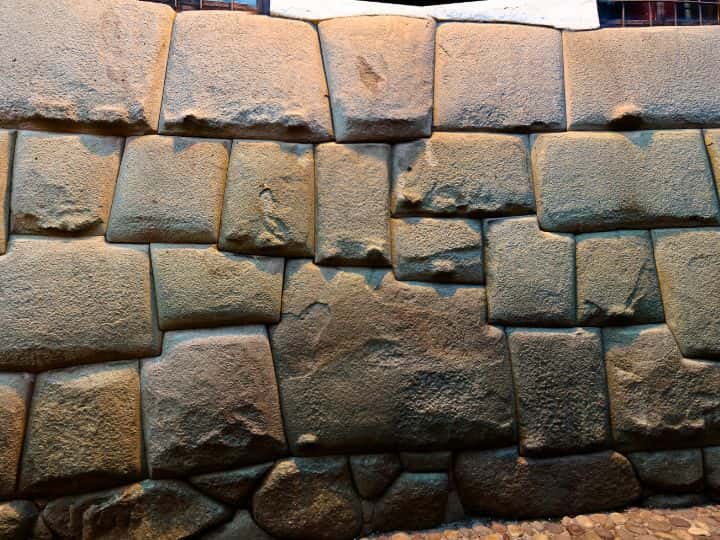
12-Angeled Stone, Cusco / 12 Days in Peru Itinerary
- Thought to have once adorned an esteemed Incan palace or temple, the 12-Angled Stone carries profound symbolism within its immaculate carvings. Many believe it represents the twelve months of the Incan calendar, reflecting the profound connection the Incas had with the celestial cycles and the natural world.
DAY 2 - Day Trip from Cusco to Sacsayhuaman, Qenko, Puka Pukara, Tambomachay, and Pisac
- Sacsayhuaman
- Qenko
- Puka Pukara
- Tambomachay
- Pisac
Today you will embark on a captivating exploration of ancient wonders in the Cusco region of Peru.
In this section of your journey, you will unravel the mysteries of Sacsayhuaman’s impressive fortress walls, delve into the intricate stonework at Qenko, witness the military ruins of Puka Pukara, marvel at the ancient water features of Tambomachay, and immerse yourself in the vibrant town of Pisac.
Prepare to be transported back in time as you discover the rich history and architectural brilliance of these extraordinary sites!
PRO TIP: The best way to reach these sites is on a private tour. With a private tour, you can have a dedicated vehicle and guide, allowing for a more personalized experience.
Joining a guided tour specifically these destinations is a popular choice. These tours provide transportation from Cusco to the sites, along with a knowledgeable guide. Check out this half-day tour, small group tour: Sacsayhuaman, Tambomachay, Puka Pukara, and Qenko.
Sacsayuaman
Sacsayhuaman is a remarkable archaeological site located just on the outskirts of Cusco. This ancient fortress showcases the architectural prowess of the Incas and offers visitors a glimpse into the grandeur of their civilization.
The site’s most striking feature is its massive stone walls, expertly crafted by Incan engineers. The walls are constructed from large stones, some weighing over 100 tons, that fit together with incredible precision. The stones are cut and shaped with such accuracy that they interlock without the use of mortar. This exceptional engineering technique, known as “ashlar,” has withstood the test of time, with many of the walls remaining intact despite centuries of exposure to the elements.
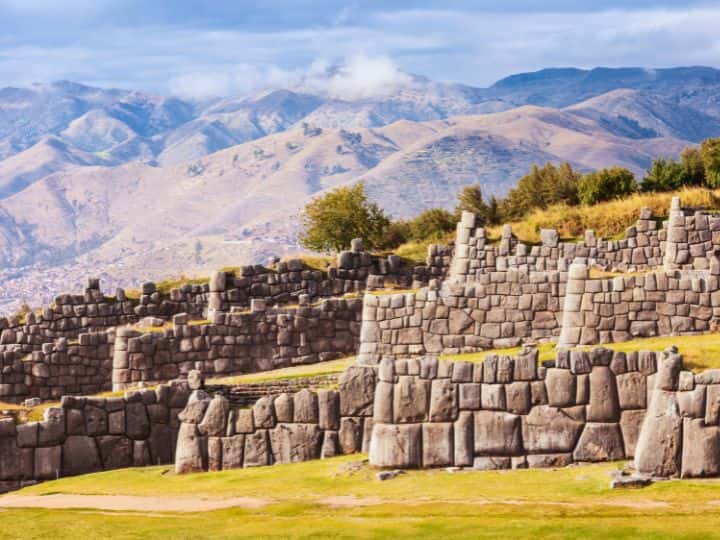
Sacsayhuaman / 12 Days in Peru Itinerary
Walking along the impressive walls of Sacsayhuaman, you can marvel at the scale and intricacy of the stonework. The precision with which the stones were placed is a testament to the Incas’ advanced knowledge of construction and architecture.
The site’s strategic location on a hill overlooking Cusco allowed it to serve as both a fortress and a ceremonial center during the Incan era.
Beyond its architectural significance, Sacsayhuaman offers breathtaking views of Cusco and the surrounding Andean landscape. From the elevated vantage point, you can appreciate the layout of the ancient Incan capital, with its distinctive terraced hills and urban planning.
The panoramic vistas make Sacsayhuaman a popular spot for photographers!

View of Cusco from Sacsayhuaman / 12 Days in Peru Itinerary
Qenko
Qenko is a mesmerizing ancient site located just a short distance from Cusco. As you step into this historic complex, you will be transported to an era when the Inca Empire flourished, and spiritual rituals held great significance.
The site’s name, “Qenko,” is derived from the Quechua word meaning “labyrinth” or “zigzag,” which aptly describes the intricate network of stone chambers and passages found here. Carved into the natural rock formations, these chambers are adorned with elaborate and precise stonework, a testament to the Inca civilization’s architectural prowess.
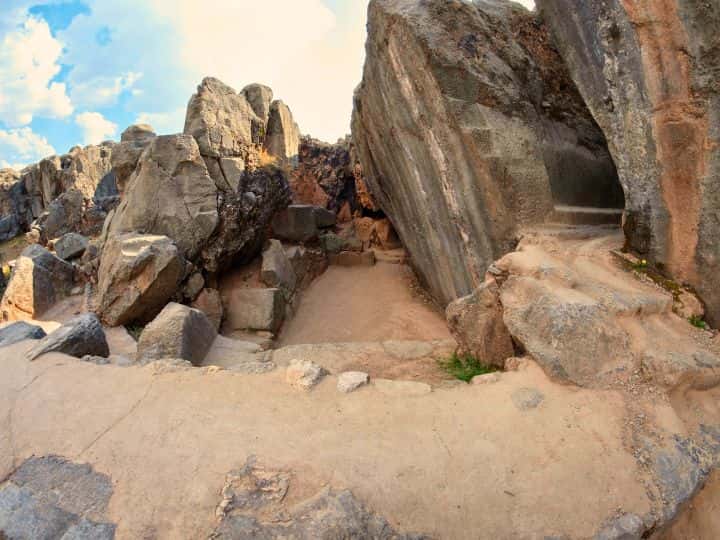
Qenko / 12 Days in Peru Itinerary
Qenko’s primary function was as a sacred place for spiritual and ceremonial rituals. The site is believed to have been dedicated to worshipping various deities and ancestral spirits.
The central feature of Qenko is an enormous rock, sculpted into a unique zigzag pattern, representing the mythological creature of the Andean worldview, the “Puma.”
As you explore Qenko’s nooks and crannies, you will encounter fascinating rock formations that resemble animal shapes, such as snakes and condors. These natural elements, integrated with the man-made stone structures, highlight the Incas’ profound connection with their surroundings and their reverence for the forces of nature.
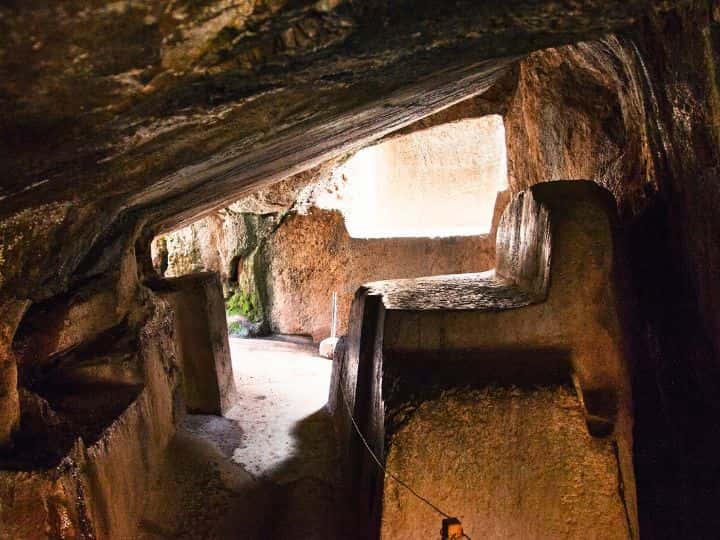
Qenko / 12 Days in Peru Itinerary
The site’s design and alignment with celestial events suggest that it played a role in astronomical observations and calendrical rituals. It is believed that the Incas conducted rituals and ceremonies during solstices and equinoxes to honor the changing seasons and celestial cycles.
Visiting Qenko allows you to step back in time and imagine the spiritual significance and vibrancy of this sacred site during the Incan era.
Puka Pukara
Puka Pukara is an intriguing archaeological site that unveils the remnants of a military fortress from the Inca period. The name “Puka Pukara” is Quechua for “Red Fort,” owing to the reddish hue of the stones used in its construction.
The site’s strategic location on a hilltop offers commanding views of the surrounding landscape, allowing it to serve as a watchtower and defensive stronghold. Many historians and archaeologists believe that Puka Pukara played a significant role in protecting important Incan sites and routes, such as Tambomachay and Sacsayhuaman.
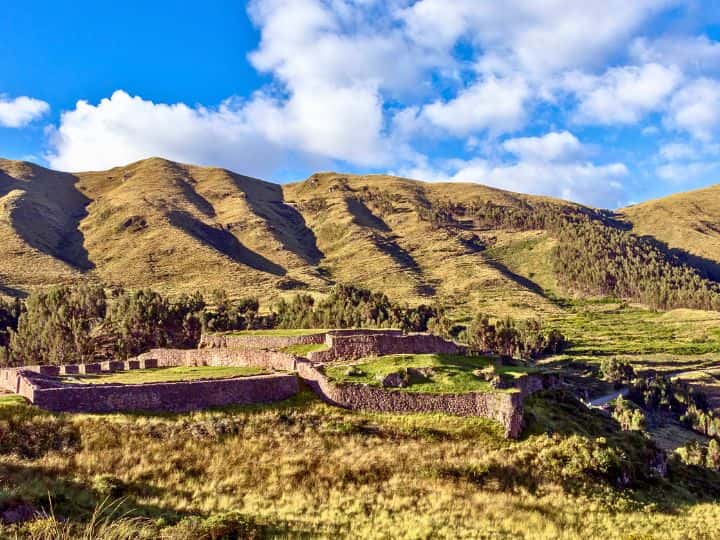
Puka Pukara / 12 Days in Peru Itinerary
The architecture of Puka Pukara exhibits the signature precision of Incan stonework, with walls built using a combination of cut stones and mortar. The incorporation of military features, such as walls with loopholes for defensive purposes, further supports the notion that it functioned as a military fortress.
In addition to its military significance, Puka Pukara likely served as a way station for travelers and traders passing through the region. It is believed that it also functioned as a resting place for the Incan elite during their journeys.
Tambomachay
Tambomachay archaeological site showcases the Incan civilization’s profound reverence for water. The name “Tambomachay” is derived from the Quechua words “tanpu” and “mach’ay,” which together mean “resting place.”
The site is renowned for its remarkable water features and aqueducts, which are a testament to the Inca’s advanced engineering and architectural skills. Tambomachay served as a place of worship and ritual, with water playing a central role in Incan ceremonies.
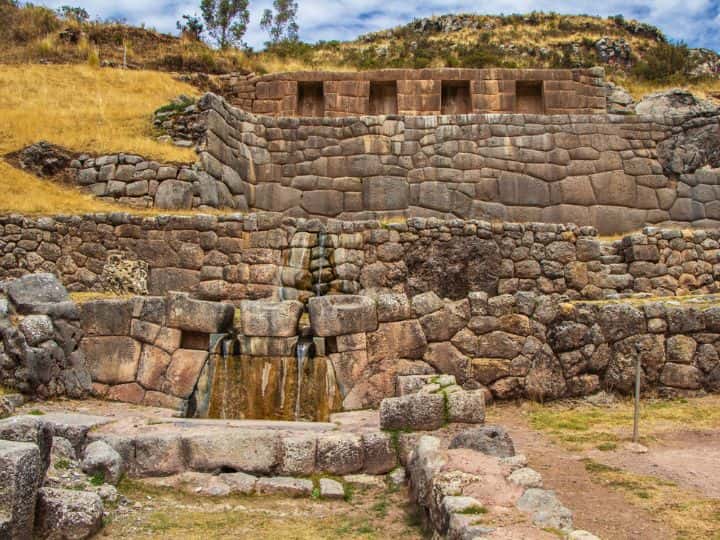
Tambomachay / 12 Days in Peru Itinerary
The intricate network of aqueducts supplied water to ceremonial baths and fountains, a symbolic representation of the Incas’ veneration of water as a source of life and purification. The precise construction and alignment of the aqueducts allowed the water to flow smoothly and consistently, even in the dry Andean climate.
The site’s architectural design incorporates finely carved stone walls, terraces, and niches, which further highlight the Incan mastery of harmonizing with the natural environment. Tambomachay’s location near natural springs added to its sacred significance as a place of water worship.
Pisac
Pisac offers a delightful blend of vibrant culture and ancient history. The town is renowned for its bustling market, which draws visitors from all over. The market is filled with an array of traditional handicrafts crafted by skilled local artisans. Here, you can find beautifully woven textiles, intricate pottery, hand-carved wooden pieces, and an assortment of jewelry, all reflecting the rich cultural heritage of the region. Bargaining is a customary practice in the market, adding to the lively and interactive shopping experience.
The market also offers an opportunity to savor authentic Peruvian cuisine and local delicacies, adding a flavorful dimension to your visit.
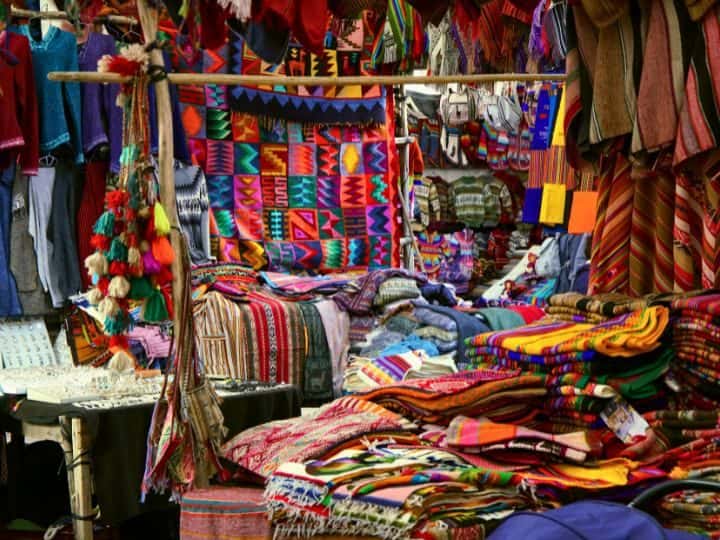
Pisac Market / 12 Days in Peru Itinerary
Aside from the bustling market, Pisac is home to ancient Incan ruins perched high above the town on a mountain ridge. The Pisac Ruins boast an impressive series of agricultural terraces, temples, and residential areas. Exploring these archaeological wonders allows you to trace the steps of the Incan civilization and marvel at their advanced engineering and architectural skills.
The panoramic views from the Pisac Ruins are nothing short of breathtaking, as they offer an uninterrupted vista of the Sacred Valley below.
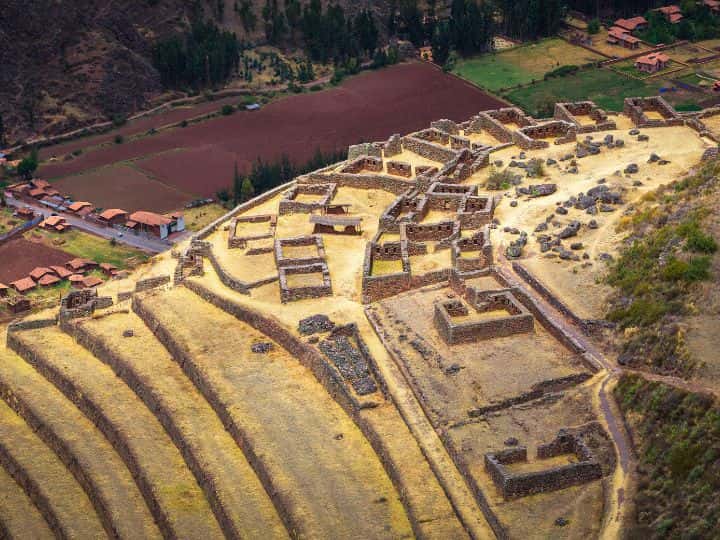
Pisac / 12 Days in Peru Itinerary
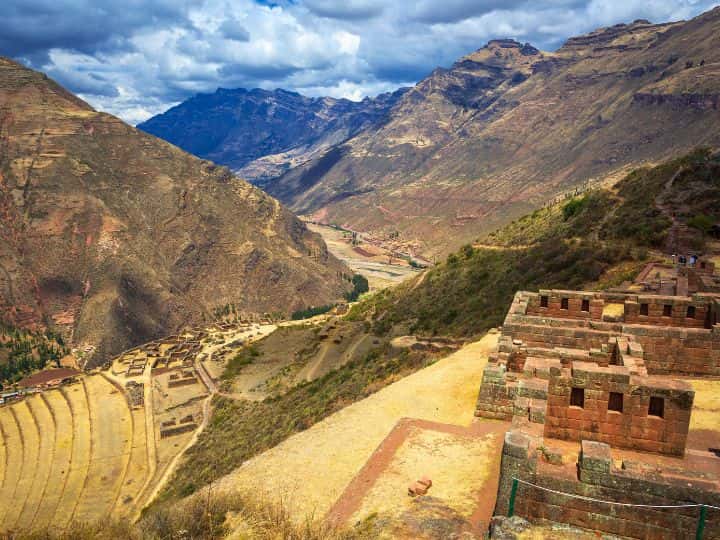
Pisac / 12 Days in Peru Itinerary
DAY 3 - Exploring the Marvels of the Sacred Valley: Maras, Moray, and Ollantaytambo
- Maras
- Moray
- Ollantaytambo
Today you will embark on a captivating day trip through the stunning landscapes of Peru’s Sacred Valley. On this adventure, you will delve into the intriguing salt mines of Maras, witness the mysterious agricultural terraces of Moray, and explore the ancient fortress of Ollantaytambo.
Get ready to be awed by the natural beauty, historical significance, and engineering marvels that await you in this enchanting region!
PRO TIP: The best way to reach Maras, Moray, and Ollantaytambo is on a private tour. With a private tour, you can have a dedicated vehicle and guide, allowing for a more personalized experience.
Joining a guided tour specifically tailored for Maras and Moray is a popular choice. These tours provide transportation from Cusco to the sites, along with a knowledgeable guide. One of the tours that you should check out is Full Day Maras, Moray, and Ollantaytambo. It is a small group (up to 14 people), full-day tour.
Maras
The Maras Salt Mines have been in operation since Incan times, producing salt through evaporation of the local saline spring waters.
The mines consist of thousands of individual salt pans, forming a striking mosaic of white crystalline salt against the mountainous backdrop.
Local families from nearby communities work together to maintain and harvest the salt, following traditional methods passed down through generations.
The intricate network of channels and pools allows for controlled water flow, ensuring the formation of high-quality salt crystals.
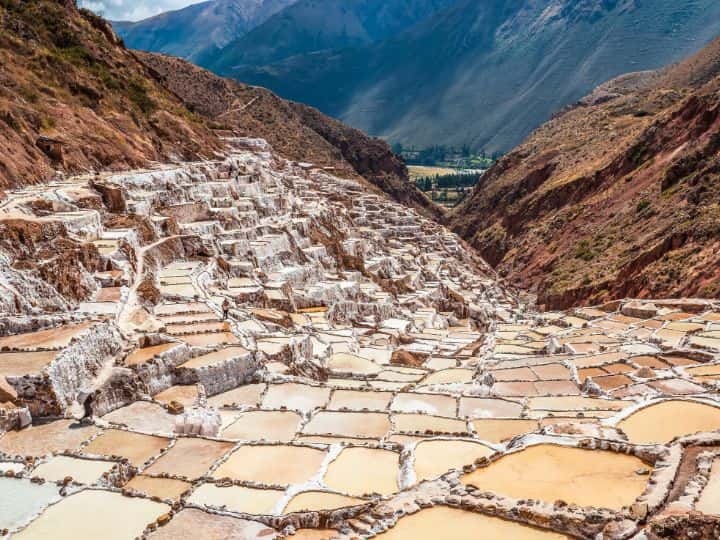
Maras Salt Mines / 12 Days in Peru Itinerary
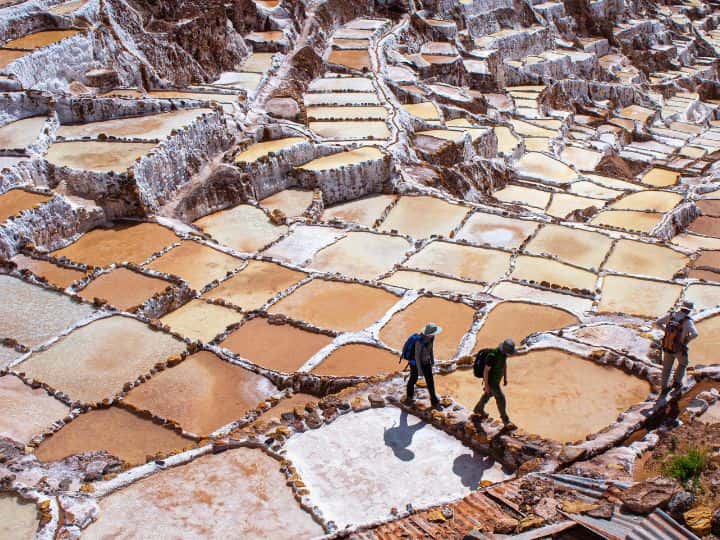
Maras Salt Mines / 12 Days in Peru Itinerary
Moray
Moray is an archaeological site featuring impressive concentric agricultural terraces, reminiscent of a natural amphitheater.
The purpose of the terraces is believed to be experimental farming, as each terrace provides a different microclimate for testing various crops.
The temperature difference between the top and bottom terraces can vary by as much as 15 degrees Celsius (27 degrees Fahrenheit), showcasing the advanced knowledge of the Incas in agriculture.
The design of Moray is thought to have been influenced by astronomical alignments and served as a sacred site for the Incas.
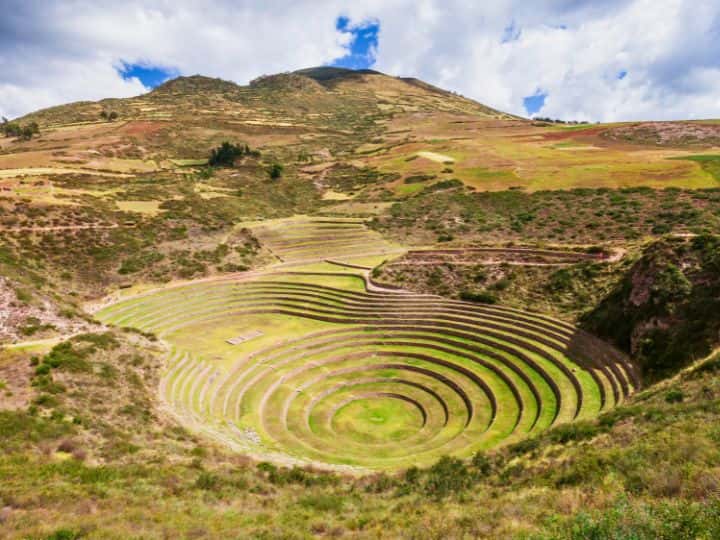
Moray / 12 Days in Peru Itinerary
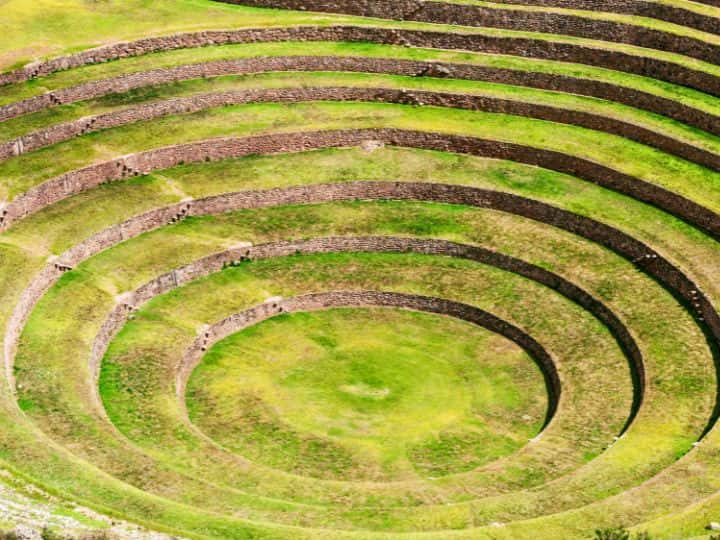
Moray / 12 Days in Peru Itinerary
Ollantaytambo
Ollantaytambo is a captivating Incan archaeological site that holds a rich tapestry of history and architectural marvels. As you wander through its well-preserved ruins, you will be transported back in time to a civilization that thrived with strategic foresight and engineering brilliance.
- Strategic Fortress and Agricultural Center
Ollantaytambo served as a strategic fortress that guarded the entrance to the Sacred Valley, making it a vital military stronghold during the Incan era. Its elevated position provided a commanding view of the surrounding valley, allowing the Incas to monitor and defend their territories effectively.
In addition to its military significance, Ollantaytambo was an essential agricultural center, with its terraced hillsides utilized for cultivating crops in the challenging Andean landscape.
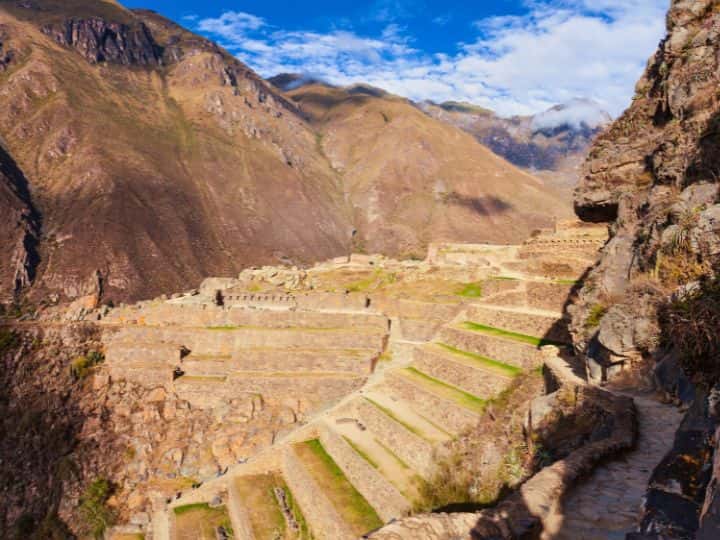
Ollantaytambo / 12 Days in Peru Itinerary
- Impressive Stone Structures and Engineering Feats
The site’s stone structures and terraces are a testament to the Incas’ advanced engineering skills. The precision with which the massive stone blocks were cut and fit together is awe-inspiring, creating walls that have withstood centuries of time.
The Incas ingeniously engineered a network of water channels that efficiently directed water from nearby streams for irrigation and domestic use, showcasing their expertise in managing precious water resources.
- Role During the Spanish Conquest
Ollantaytambo played a significant role during the Spanish conquest of Peru.
When the conquistadors, led by Francisco Pizarro, arrived in the region, the site served as a strategic stronghold for the Incas to resist the invasion. The well-organized layout of the terraces and fortified structures provided a temporary victory for the Incas, as they successfully defended the site against the Spanish forces in the Battle of Ollantaytambo.
The site’s historical importance during this critical period of Peruvian history adds depth to its allure and significance.
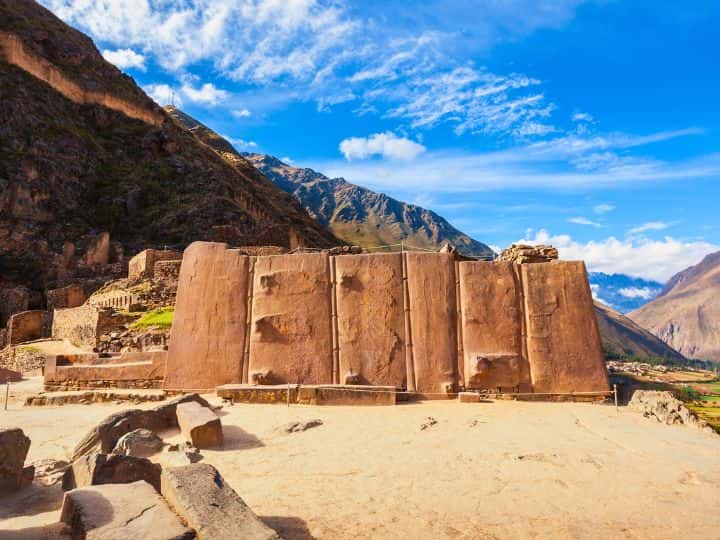
Ollantaytambo / 12 Days in Peru Itinerary
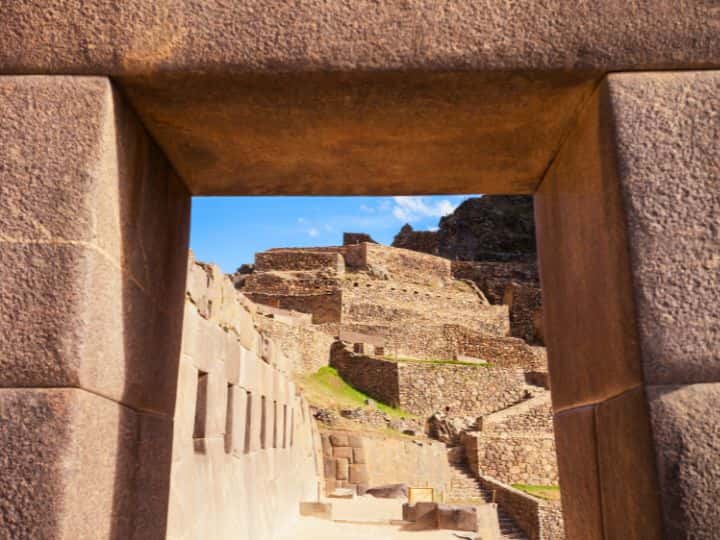
Ollantaytambo / 12 Days in Peru Itinerary
- Ingenious Construction Techniques
One of the most astonishing aspects of Ollantaytambo is the transportation and placement of its massive stone blocks. The stones used in the construction of the fortress were sourced from quarries located several miles away.
The Incas displayed extraordinary ingenuity in moving these enormous blocks across rugged terrains, using a combination of ramps, sleds, and human labor.
The precision and craftsmanship with which the stones were cut and fitted together illustrate the Incas’ mastery of construction techniques and their deep reverence for the art of building.
Ollantaytambo is a living testament to the enduring legacy of the Inca Empire and a destination that will leave you in awe of the architectural brilliance of this ancient civilization.
Day 4 - Day Trip from Cusco to Rainbow Mountain - Exploring the Vibrant Heights
- Rainbow Mountain
Today you will embark on an extraordinary day trip from Cusco to Rainbow Mountain, a natural wonder that will leave you awe-inspired.
Located in the Peruvian Andes, this majestic mountain showcases a kaleidoscope of vibrant colors, created by the presence of various minerals in the rock layers. Get ready for an exhilarating hike through stunning landscapes as you discover this unique geological phenomenon.
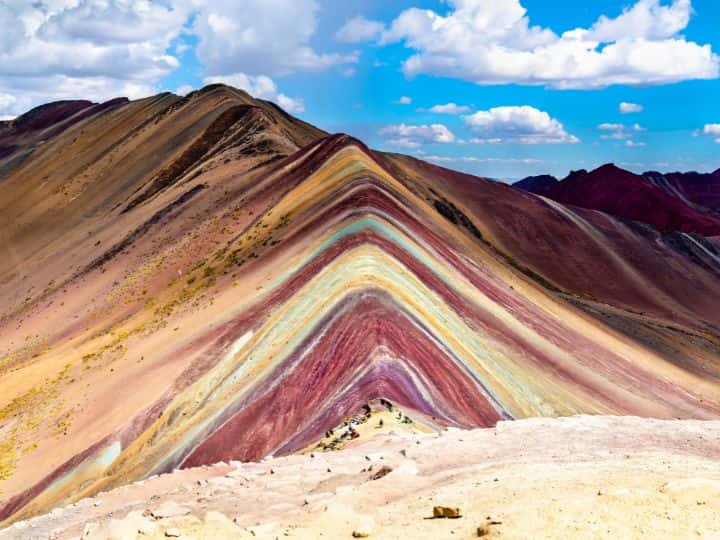
Rainbow Mountain / 12 Days in Peru Itinerary
PRO TIP: When planning a day trip from Cusco to Rainbow Mountain, there are several transportation options to consider:
- Organized Tour: Joining an organized tour is probably the most popular and convenient option for visiting Rainbow Mountain. Numerous tour companies in Cusco offer day trips to Rainbow Mountain, providing transportation from Cusco to the trailhead and guiding you along the trek. This option eliminates the need for individual logistics and allows you to focus on enjoying the experience.
Here is a tour that you might want to check out: Rainbowbow Mountian – Full-Day Tour. Another popular option is Rainbow Mountain with ATVs.
- Private Transfer: For a more personalized and flexible experience, you can arrange a private transfer from Cusco to the trailhead of Rainbow Mountain. This option offers greater control over your itinerary and allows you to customize the trip according to your preferences.
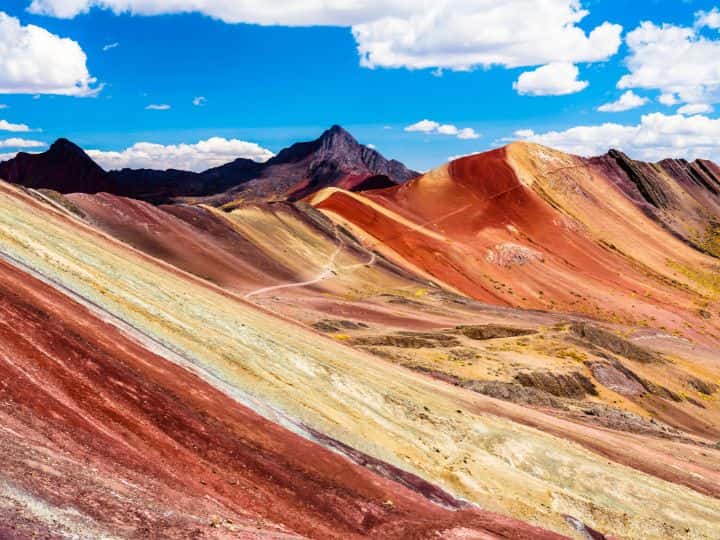
Rainbow Mountain / 12 Days in Peru Itinerary
GOOD TO KNOW:
- Rainbow Mountain, also known as Vinicunca, rises majestically to an elevation of 5,200 meters (17,060 feet) above sea level.
- The mountain’s distinctive colors, ranging from hues of red, pink, yellow, and turquoise, are a result of the mineral-rich composition of the sedimentary layers.
- It remained hidden beneath a thick layer of ice and snow for centuries before being exposed due to glacial retreat.
- The vibrant colors of Rainbow Mountain create a breathtaking and otherworldly landscape, attracting adventurers and nature enthusiasts from around the world.
Here is what you need to know about the hiking experience:
- The hike to Rainbow Mountain is challenging and requires a good level of fitness due to the high altitude and steep sections.
- The trail takes you through picturesque valleys, past grazing alpacas and llamas, and offers stunning views of snow-capped peaks.
- The hike typically spans around 7 to 9 kilometers (4 to 5.5 miles), taking approximately 3 to 4 hours to reach the summit.
- It is recommended to acclimate to the altitude in Cusco for a few days before attempting the hike to minimize the effects of altitude sickness.
- Reaching the summit of Rainbow Mountain rewards you with breathtaking panoramic views of the surrounding mountain ranges and valleys.
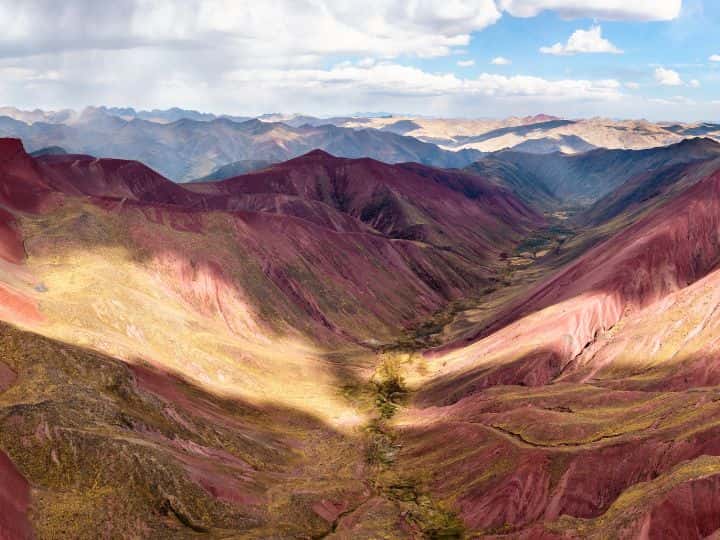
Red Valley Near Rainbow Mountain / 12 Days in Peru Itinerary
PRO TIP: Be prepared for changing weather conditions, as the high altitude can bring chilly temperatures and swift weather changes.
Day 5 - Journey to Aguas Calientes: Gateway to Machu Picchu and Exploration of Aguas Calientes
- Journey from Cusco to Aguas Calientes – Gateway to Machu Picchu
- Exploring Aguas Calientes
- Overnight in Aguas Calientes
Today you are going to start a captivating journey to the renowned UNESCO World Heritage Site, Machu Picchu.
Day 5 involves reaching Aguas Calientes, the gateway to Machu Picchu, while Day 6 is dedicated to witnessing the breathtaking sunrise over the ruins, exploring the awe-inspiring citadel, and returning to Cusco with memories that will last a lifetime.
Journey from Cusco to Aguas Calientes: Gateway to Machu Picchu
One of the most convenient ways to reach Machu Picchu (without hiking) is by taking the train.
There are two train companies available: the PeruRail and the Inca Rail.
The train journey will take you through breathtaking landscapes of the Andes Mountains and lush valleys, providing a scenic and comfortable ride to Machu Picchu.
PRO TIP: Be prepared to book your train tickets at least 6-4 months in advance to secure the best departure and arrival times, as well as be able to select the train class that is the best for your budget.
GOOD TO KNOW: Make a note that there is no train station precisely in Cusco but rather there is Poroy Train Station and which is located about 20 minutes from Cusco. In my opinion, the best way to get to Poroy Train Station is to take a taxi. My hotel arranged a taxi for me. It cost me 50 soles. However, if you book a taxi yourself, or catch a taxi from downtown Cusco, it will cost you much less, around 20-30 soles.
Make another note that there is no train station exactly at the Inca Citadel of Machu Picchu. The train will take you to Aguas Calientes (Machu Picchu Pueblo).
Poroy Train Station is 86 km (54 miles) from Aguas Calientes. The trip takes about 3 hours and 20 minutes.
Exploring Aguas Calientes
Aguas Calientes, also known as Machu Picchu Pueblo, is a small town located in the Urubamba River Valley in Peru, near the famous ancient Inca city of Machu Picchu. It serves as a base for tourists visiting Machu Picchu.
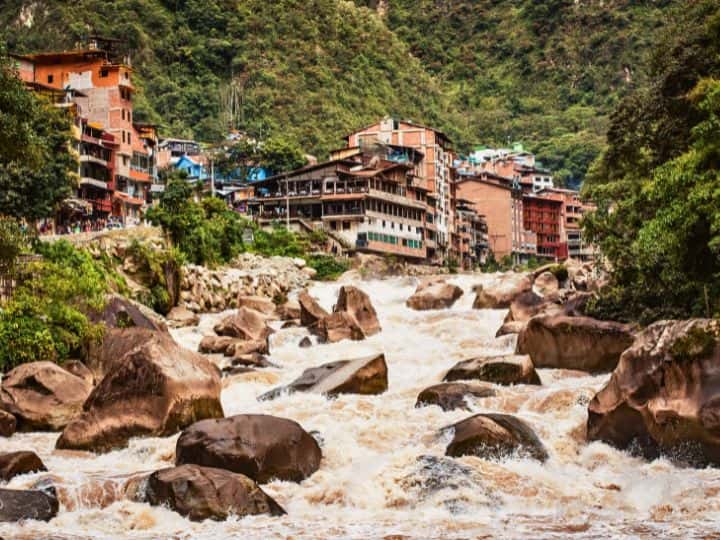
Aguas Calientes / 12 Days in Peru Itinerary
- How to Get Around in Aguas Calientes
Aguas Calientes is a small town, and most places of interest are within walking distance. You can easily explore the town on foot and get to restaurants, shops, and other attractions.
- Where to Stay in Aguas Calientes
My first choice is Tierra Viva Machu Picchu Hotel. First of all, the location is great. It is close to the train station and right by the bus stop that leaves for Machu Picchu. The rooms are nice, the beds are comfy and the shower has hot water. Breakfast. is included and it offers a variety of fruits, bread, and yogurts. They have an on-site restaurant which is very convenient.
Casa del Sol Machupicchu is another good one in Aguas Calientes. The location is perfect! The rooms are a good size with comfortable beds. You will like their breakfast with lots of choices. Make sure to book a room with a river view.
Exploring Aguas Calientes
While Machu Picchu is undoubtedly the highlight of Aguas Calientes, there are plenty of other activities and experiences to enjoy in this charming town and its surrounding areas.
Here are a few things worth checking out in Aguas Calientes:
Manuel Chavez Ballon Site Museum
Manuel Chavez Ballon Site Museum, also known as Machu Picchu Museum, is one coolest things to do in Aguas Calientes before heading out to Machu Picchu. It will give you an understanding of the Inca culture and insight into the construction of the Machu Picchu citadel.
Butterfly House Machupicchu
The Mariposario de Machupicchu, also known as the Butterfly House Machupicchu, is a butterfly sanctuary and a local conservation project dedicated to studying local butterfly species as well as increasing the butterfly population through a reproduction-and-release program. The project is run by Leonardo Serrano Gutierez.
The Hot Springs
The Hot Springs (Banos Termales) in Aguas Calientes is located in a beautiful natural setting, surrounded by lush vegetation and the sounds of the Vilcanota River, so take your time and relax, unwind, and appreciate the serene atmosphere of the hot springs.
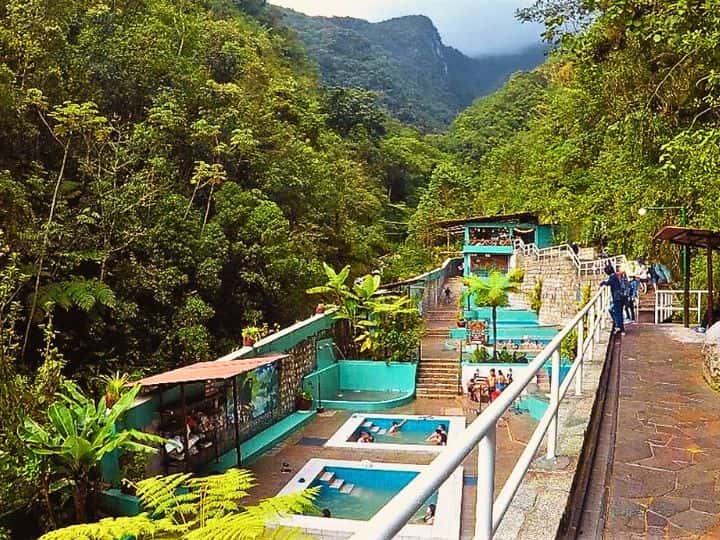
Aguas Calientes / 12 Days in Peru Itinerary
Overnight in Aguas Calientes
After a train journey and an exhilarating half-day of exploration in Aguas Calientes, take the opportunity to hit the bed early.
Allow yourself to recharge for the awe-inspiring experience that awaits you at dawn!
Day 6 - Machu Picchu Exploration
- Sunrise at Machu Picchu
- Tour of Machu Picchu City of the Incas
- Journey Back to Cusco
Day 6 is dedicated to witnessing the breathtaking sunrise over the ruins, exploring the awe-inspiring citadel, and returning to Cusco with memories that will last a lifetime.
Sunrise at Machu Picchu
You will need to begin your day super early! You need to be up and ready to go no later than about 3:30 am to 4 am.
You will start by taking a bus from Aguas Calientes to the entrance of Machu Picchu, arriving in time for the mesmerizing sunrise. The bus ride takes about 15-20 minutes.
The line for buses going to Machu Picchu starts forming at about 3:30 am. You need to be on one of the first buses leaving for Machu Picchu to make it for sunrise.
PRO TIP: Make sure to buy your bus tickets as soon as you arrive in Aguas Calientes!
GOOD TO KNOW: Instead of taking a bus, you can hike from Aguas Calientes to Machu Picchu. It is a 2 to 3-hour strenuous hike, however, it is a very popular hike. If you want to make it for sunrise, you will be hiking in darkness, so a flashlight or a headlamp is recommended.
Experiencing the sunrise at Machu Picchu is a dream come true, a bucket-list moment that captures the very essence of awe and wonder!
As the first rays of the sun ascend the horizon, they tenderly embrace the stone citadel, unveiling a breathtaking spectacle. The ethereal beauty of Machu Picchu emerges, bathed in a gentle, golden glow, casting a spell of enchantment upon all who bear witness.
In this magical moment, you will find yourself transported through time, standing amidst the ancient stonework and sacred temples carefully crafted by the hands of the Incan civilization.
Tour of Machu Picchu City of the Incas
Next, it is time to discover the wonders of Machu Picchu, the mesmerizing “City of the Incas,” where ancient ruins stand as a testament to the ingenuity and spiritual reverence of the Incan civilization.
As you start your exploration of this extraordinary archaeological site, be sure not to miss the captivating highlights that hold the secrets of a bygone era. From sacred temples and ritual stones to breathtaking vistas and intricate terraces, each moment at Machu Picchu unveils the enigmatic allure of a once-thriving ancient civilization.
Let us guide you through the must-see treasures that await you in this UNESCO World Heritage Site, where history comes alive amidst the splendor of the Andean mountains.
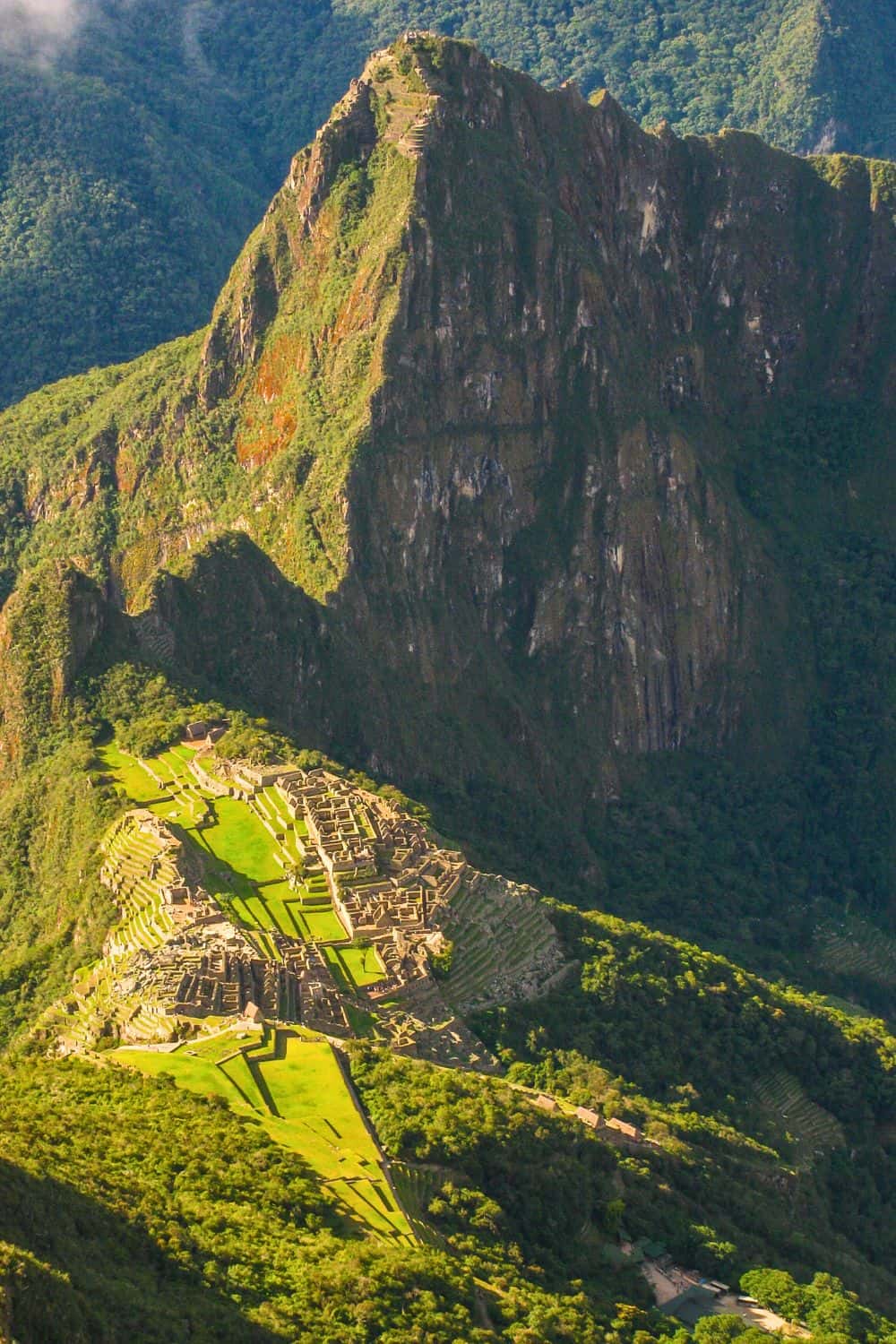
Machu Picchu / 12 Days in Peru Itinerary
Machu Picchu – City of the Incas: Must-See Highlights
- Intihuatana Stone: An ancient ritual stone, believed to have served as a solar observatory and spiritual center for the Incas.
- Temple of the Sun (Torreón): A remarkable semi-circular structure dedicated to the worship of the sun god Inti, featuring exquisite stonework.
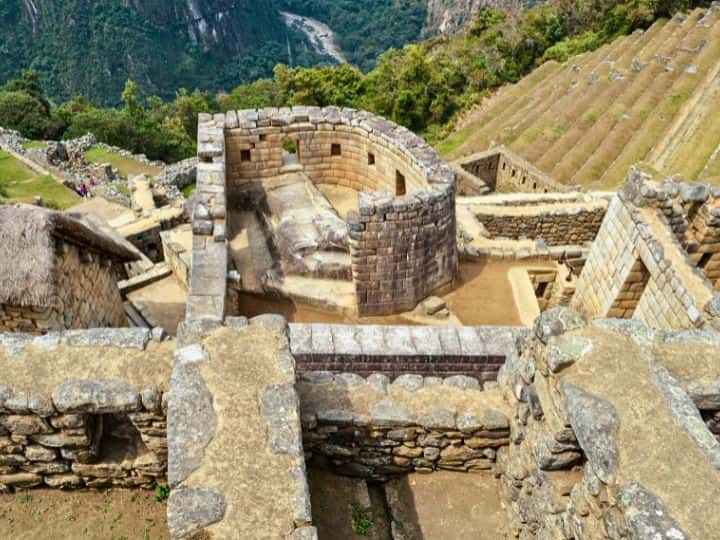
Aguas Calientes / 12 Days in Peru Itinerary
- Temple of the Condor: A unique rock formation that resembles a condor in flight, symbolizing the Incan connection to nature and the spirit world.
- The Sacred Rock: A massive boulder with sacred carvings, possibly used for rituals or offerings by the Inca priests.
- Sun Gate (Intipunku): The original entrance to Machu Picchu from the Inca Trail, offering breathtaking views of the citadel and surrounding landscapes.
- Main Plaza (Hanan): The heart of Machu Picchu, where important ceremonies and gatherings took place, surrounded by significant temples and structures.
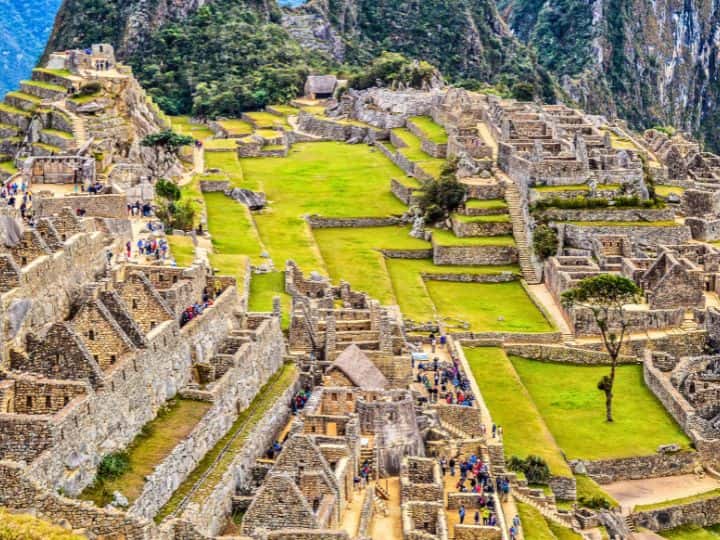
Aguas Calientes / 12 Days in Peru Itinerary
- Intihuatana Terrace: A terraced area featuring the enigmatic Intihuatana stone, where the Incas connected with cosmic forces and celestial events.
- Agricultural Terraces: The impressive farming terraces that cascade down the mountainside, showcasing the Incas’ advanced knowledge of engineering and agriculture.
- Temple of the Three Windows: An enigmatic three-windowed temple, showcasing intricate Incan masonry and offering stunning panoramic views of the surrounding mountains.
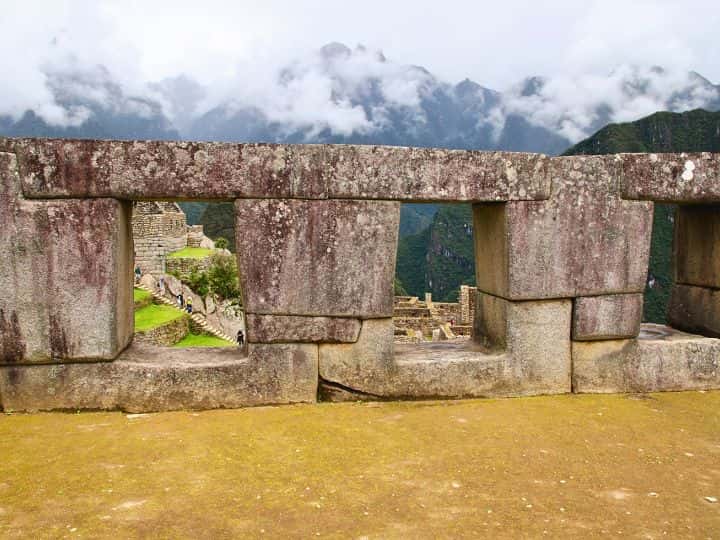
Temple of the Three Windows / 12 Days in Peru Itinerary
- Guardhouse (Casa del Guardián): An iconic structure located at the entrance, where visitors often take postcard-worthy photos of Machu Picchu.
- Terraced Fields (Agricultural Sector): Explore the lower agricultural terraces, where the Incas cultivated various crops and maintained a sustainable way of life.
These are just a few highlights of the treasures that await you at Machu Picchu. As you wander through the ancient city, keep an eye out for the small details and the hidden stories etched into the stones, making this archaeological wonder a living testament to the ingenious culture of the Incas.
Journey Back to Cusco
As the sun bids farewell to the ancient citadel of Machu Picchu, I bet your heart brims with memories of an unforgettable day. The journey back to Cusco will be accompanied by a sense of fulfillment and wonder, as you reflect on the marvels witnessed at the City of the Incas. The scenic train ride through the Andean landscapes will offer moments of quiet contemplation.
Upon arriving in Cusco, the city will warmly embrace you with its cobblestone streets and charming plazas, inviting you to unwind and rest.
As the sun sets over the horizon, you will need to prepare for the next chapter of your adventure – a 3-day exploration of the enchanting Peruvian Amazon.
Day 7 - Journey into Tambopata National Preserve: the Heart of Peruvian Amazon
- Journey from Cusco into Tambopata National Preserve: the Heart of Peruvian Amazon
- Night Walk Excursion in Tambopata Rainforest
Today, you will embark on a thrilling adventure into the heart of the Amazon rainforest in Peru!
Over the next 3 days, you will venture into the biodiverse Tambopata National Preserve, specifically staying at Refugio Amazonas Lodge.
Prepare to immerse yourself in the mesmerizing beauty of the jungle, encounter incredible wildlife, and experience the unique sights and sounds of one of the world’s most diverse ecosystems.
GOOD TO KNOW: There are many tour companies in Tambopata National Preserve. After much research, I selected Rainforest Expeditions. After spending 3 days with them and participating in all the excursions, I have to say that they are top-notch! I am not promoting them and I am not getting paid for mentioning them here.
Journey from Cusco to Tambopata National Preserve
To get to Tambopata National Preserve, take a domestic flight from Cusco to Puerto Maldonado, the gateway to the Amazon rainforest.
Upon arrival, you will be met by your local guide and embark on a scenic boat journey along the Tambopata River to Refugio Amazonas.
Settle into the lodge, located amidst the lush rainforest, and receive an orientation to familiarize yourself with the area.
Explore the lodge’s surroundings, observing the diverse bird species and listening to the symphony of jungle sounds.
Night Walk Excursion in Tambopata Rainforest
Embark on a thrilling Night Walk Excursion in the Tambopata Rainforest, an immersive journey into the mysterious world of nocturnal creatures.
As the sun sets, the rainforest comes alive with a symphony of sounds and unseen movements.
Guided by expert naturalists, venture deep into the heart of the Amazon, where the inky darkness reveals a whole new realm of wildlife.
Armed with flashlights, witness the mesmerizing glow of bioluminescent insects and the reflective eyes of night-dwelling creatures. Listen to the enchanting calls of nocturnal birds and the haunting melodies of tree frogs.
During this captivating adventure, you will gain a profound appreciation for the delicate balance of nature in the darkness and unlock the secrets of the Tambopata Rainforest’s nocturnal wonders.
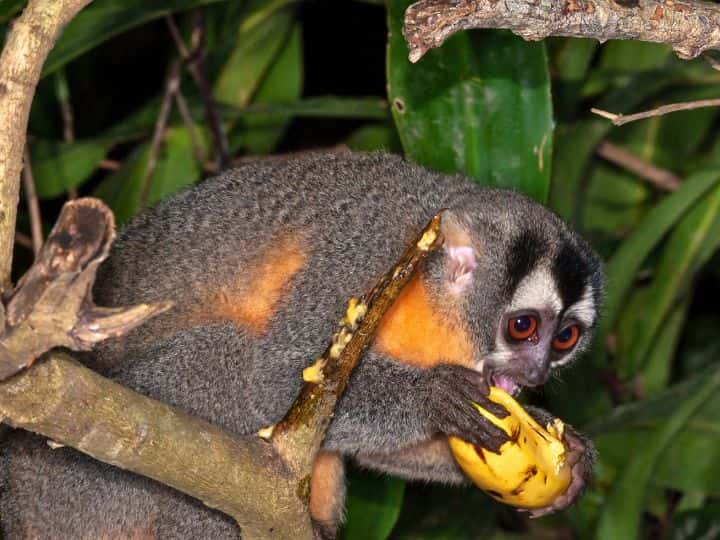
Tambopata Rainforest / 12 Days in Peru Itinerary
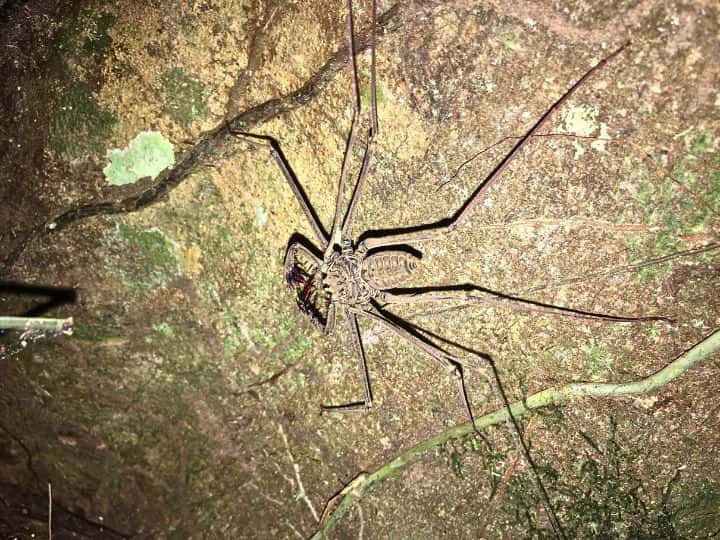
Tambopata Rainforest / 12 Days in Peru Itinerary
Day 8 - Tambopata Rainforest Adventures - Macaw Clay Lick and Mammal Clay Lick Encounter
- Chuncho Macaw Clay Lick Excursion: A Colorful Spectacle in Tambopata Rainforest
- Mammal Clay Lick Excursion
Day 2 in the Tambopata Rainforest promises an exhilarating continuation of your Amazon adventure, with two captivating excursions that offer a glimpse into the vibrant biodiversity of this pristine wilderness.
First, you’ll embark on the Chuncho Macaw Clay Lick Excursion, a unique opportunity to witness the breathtaking spectacle of colorful macaws and parrots gathering at clay licks to indulge in essential minerals. Marvel at the vivid plumage and raucous calls of these magnificent birds as they create a vivid tableau against the lush green backdrop of the rainforest.
Next, the Mammal Clay Lick Excursion awaits, where you’ll have the chance to encounter diverse mammal species, including tapirs, peccaries, and even elusive jaguars, attracted to the mineral-rich soil. Guided by experienced naturalists, these extraordinary encounters will deepen your connection with the intricate web of life that thrives within the Tambopata Rainforest, leaving you with indelible memories of nature’s wonder and splendor.
Chuncho Macaw Clay Lick Excursion
The Chuncho Macaw Clay Lick Excursion in Tambopata Rainforest is an awe-inspiring encounter with nature’s vibrant palette.
As the sun rises, venture deep into the heart of the Amazon, guided by expert naturalists to witness an extraordinary spectacle. At the clay lick, a unique formation of mineral-rich clay, an array of magnificent macaws and parrots gathers in a dazzling display of colors.
Marvel at the resplendent hues of scarlet, blue, green, and gold as these captivating birds arrive in a chorus of calls and wings, their vivid plumage painting the rainforest with stunning vibrancy.
Capturing this natural wonder with your senses, observe the macaws indulging in the clay, a behavior that helps them neutralize toxins in their diet and aids in digestion. This unforgettable excursion offers an intimate connection with the wild majesty of the Tambopata Rainforest and a profound appreciation for the delicate balance of life within this biodiverse paradise.
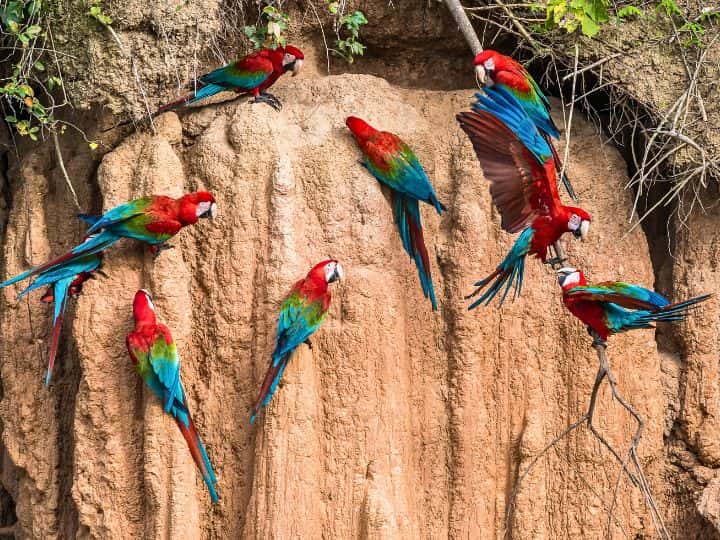
Chuncho Macaw Clay Lick / 12 Days in Peru Itinerary
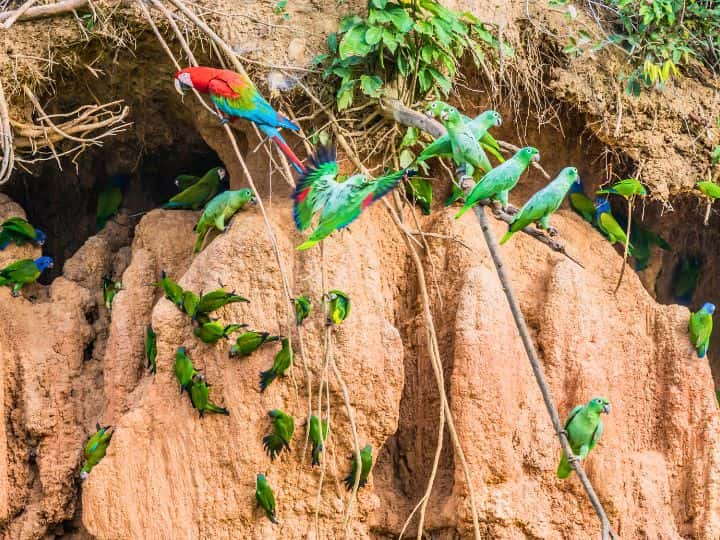
Chuncho Macaw Clay Lick / 12 Days in Peru Itinerary
Mammal Clay Lick Excursion
Embark on the Mammal Clay Lick Excursion in Tambopata Rainforest for an extraordinary opportunity to witness the captivating wildlife that thrives in this pristine ecosystem.
Guided by experienced naturalists, venture into the depths of the rainforest, where a hidden clay lick attracts a diverse array of mammal species. Keep your eyes peeled for the elusive tapirs, peccaries, and even the majestic jaguars that are enticed by the mineral-rich soil.
As you observe these magnificent creatures in their natural habitat, learn about their behaviors, feeding patterns, and the vital role clay licks play in their well-being.
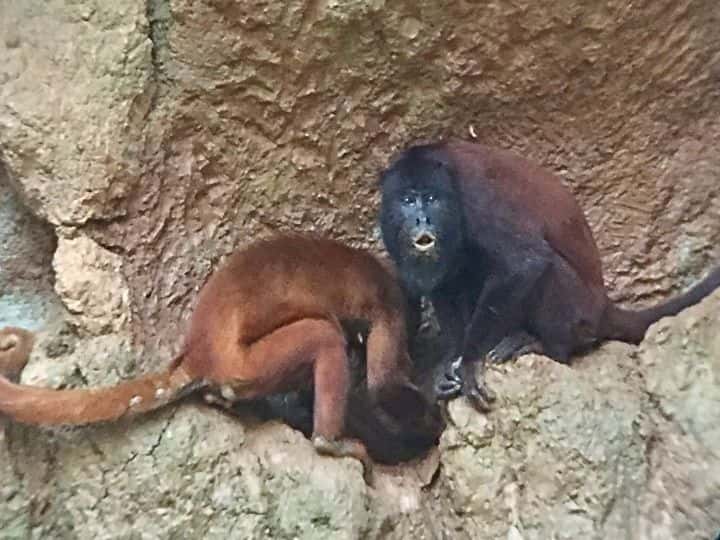
Mammal Clay Lick / 12 Days in Peru Itinerary
Day 9 - Tambopata Rainforest Adventures - Canopy Observation Tower and Journey to Lima
- Sunrise Canopy Observation Tower Excursion
- The Journey from Tambopata National Reserve to Lima
- Arrival in Lima: Getting Around and Places to Stay
- Miraflores Exploration
Day 9 of your Peruvian adventure begins with a breathtaking Sunrise Canopy Observation Tower Excursion in Tambopata Rainforest, immersing you in the enchanting morning ambiance of the Amazon.
As the day unfolds, you will bid farewell to Tambopata National Reserve and embark on a journey to Lima.
Upon arriving in Lima, the coastal capital beckons with an afternoon of exploration in the vibrant district of Miraflores, where you can relish the coastal views, indulge in delicious cuisine, and savor the fusion of history and modernity that defines this dynamic city.
Day 9 presents a perfect blend of nature’s tranquility and urban allure, promising unforgettable experiences of your remarkable Peruvian escapade.
Sunrise Canopy Observation Tower Excursion in Tambopata
The Sunrise Canopy Observation Tower Excursion in Tambopata Rainforest offers an awe-inspiring experience to witness the beauty of the Amazon awakening with the first light of day.
Early in the morning, you will venture into the heart of the rainforest with your guide, making your way to the canopy tower, which stands tall above the treetops.
As the sun rises over the horizon, the forest comes to life with the melodious calls of birds and the gentle rustling of leaves.
From the canopy tower, you will have an unparalleled vantage point to observe the diverse wildlife that inhabits the rainforest. Keep an eye out for vibrant toucans, parrots, and macaws as they take flight through the morning mist, creating a mesmerizing sight against the backdrop of the lush greenery.
The observation tower also provides a unique opportunity to witness the daily activities of the rainforest residents. Monkeys may leap from branch to branch, searching for breakfast, while other elusive creatures may emerge from their hidden abodes.
As you stand amidst the canopy, you will feel a profound connection to the thriving ecosystem that surrounds you.
The Sunrise Canopy Observation Tower Excursion is not only a feast for the senses but also an educational experience. Your guide will share insights about the rainforest’s ecology, the behavior of its inhabitants, and the significance of preserving this precious ecosystem.
This magical morning adventure offers a serene and reflective start to your day, leaving you with memories of a truly unforgettable sunrise in the heart of the Tambopata Rainforest.
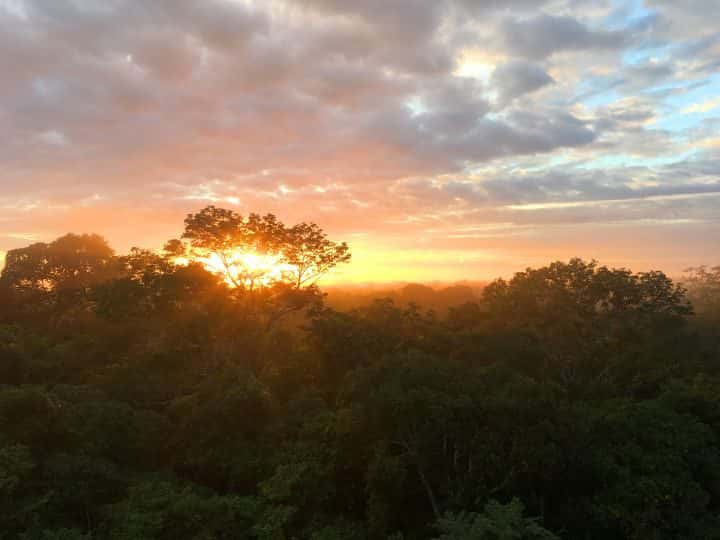
Sunrise Canopy Observation Tower Excursion / 12 Days in Peru Itinerary
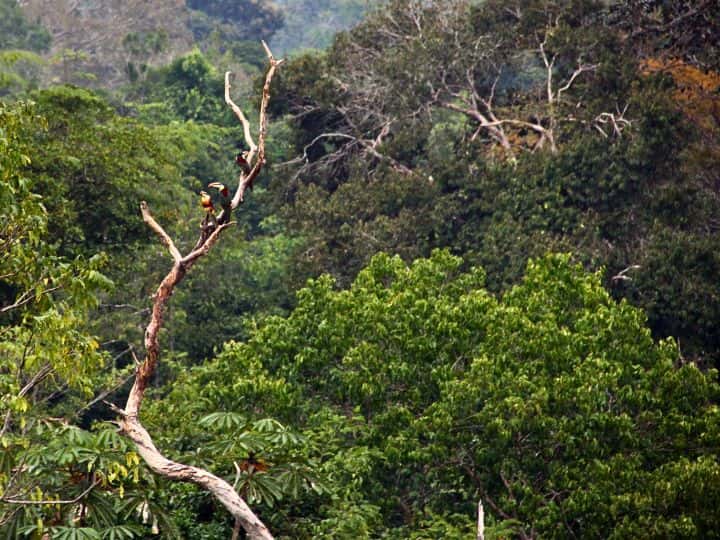
Sunrise Canopy Observation Tower Excursion / 12 Days in Peru Itinerary
The Journey from Tambopata National Reserve to Lima
It is time to say goodbye to Tambopata National Reserve and embark on a journey to Lima.
This journey typically involves a combination of transportation modes to cover the distance between the two locations.
- Tambopata National Reserve to Puerto Maldonado: From the Tambopata National Reserve, you will travel back to Puerto Maldonado, the gateway city to the rainforest. The journey may be by boat or land, depending on the lodge’s location within the reserve. As you depart from the reserve, take in the last glimpses of the pristine rainforest and the natural wonders you encountered during your stay.
- Puerto Maldonado to Lima: From Puerto Maldonado to Lima, you will take a direct domestic flight. The flight duration from Puerto Maldonado to Lima is approximately 1 hour and 45 minutes, providing a convenient and straightforward way to travel back to the capital city.
Arrival in Lima - Getting Around and Places to Stay
Upon arriving in Lima, you’ll find a variety of transportation options to get around the city and numerous accommodation choices to suit your preferences and budget.
Getting Around in Lima
- Metropolitano Bus System: The Metropolitano is a reliable and efficient bus system that provides an excellent way to get around Lima.
Purchase a rechargeable “tarjeta” card at any Metropolitano station and load it with credit. This card can be used for multiple trips, and you can easily recharge it when needed. Just tap the card on the reader when boarding and exiting the bus to deduct the fare.
The Metropolitano operates on dedicated bus lanes, separate from regular traffic, which helps minimize delays and allows for faster and more reliable travel. This is especially advantageous during peak hours when traffic congestion is common.
- Taxis and Ride-Sharing Apps: Look for licensed taxis that display identification, such as a visible taxi company logo and registration number.
Ride-sharing apps like Uber and Beat are popular and reliable alternatives to traditional taxis in Lima.
Places to Stay in Lima
- Miraflores: Miraflores is a popular neighborhood for tourists, offering a wide range of accommodations, from luxurious hotels to budget-friendly hostels. It boasts stunning coastal views, parks, shopping, and a vibrant dining scene.
- Barranco: Barranco is an artsy and bohemian neighborhood known for its colorful streets, art galleries, and lively nightlife. It offers boutique hotels and charming guesthouses.
- San Isidro: San Isidro is a sophisticated area with upscale hotels, fine dining, and beautiful parks, making it an ideal choice for travelers seeking a more refined ambiance.
- Here are some of the hotels that I stayed at:
Belmond Miraflores Park is a luxury hotel that offers stunning ocean views, elegant rooms, and top-notch service. It features a rooftop pool, a spa, and a renowned restaurant with panoramic views.
JW Marriott Hotel Lima, situated on the Malecón, this upscale hotel offers luxurious rooms, excellent amenities, and breathtaking views of the ocean. It boasts multiple restaurants, a fitness center, and a rooftop pool.
Iberostar Selection Miraflores offers modern and comfortable accommodations and excellent on-site amenities. The hotel features well-appointed rooms and suites with stylish decor and modern amenities. You will be able to indulge in delicious dining options, including international cuisine and Peruvian specialties while enjoying stunning views from the rooftop bar. There is an outdoor pool and fitness center.
Miraflores Exploration
Afternoon and evening in Miraflores offer a delightful blend of coastal charm, culinary delights, and lively entertainment.
Here’s how you can make the most of your time in this vibrant neighborhood of Lima:
Larcomar Shopping Center
Begin your afternoon at Larcomar, an upscale shopping center perched on the cliffs overlooking the Pacific Ocean.
Enjoy a leisurely stroll along the outdoor walkways, taking in the breathtaking coastal views and browsing through a variety of shops offering local and international brands.
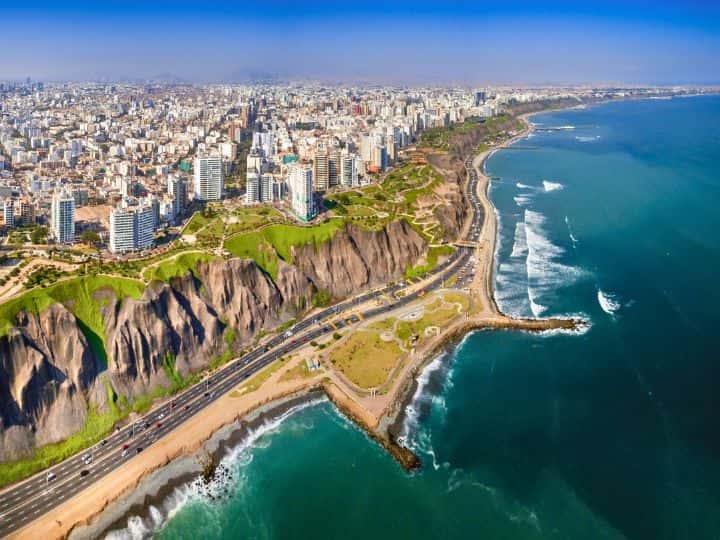
Room of the Three Windows / 12 Days in Peru Itinerary
Parque del Amor (Love Park)
Located nearby, Parque del Amor is a picturesque park adorned with colorful mosaics and a romantic sculpture of a couple in an embrace. Enjoy the panoramic views of the ocean and take a moment to capture a memorable photo with the iconic El Beso (The Kiss) statue.
Kennedy Park
Head to Kennedy Park, known as the heart of Miraflores, for a taste of local life. This lively park is a gathering place for both residents and visitors, with street performers, artisanal markets, and green spaces to relax and people-watch.
Sunset at Malecón de Miraflores
As the sun begins to set, make your way to the Malecón de Miraflores, a beautiful coastal boardwalk that stretches along the cliffs. Enjoy the stunning sunset over the Pacific Ocean, creating a breathtaking backdrop for your evening.
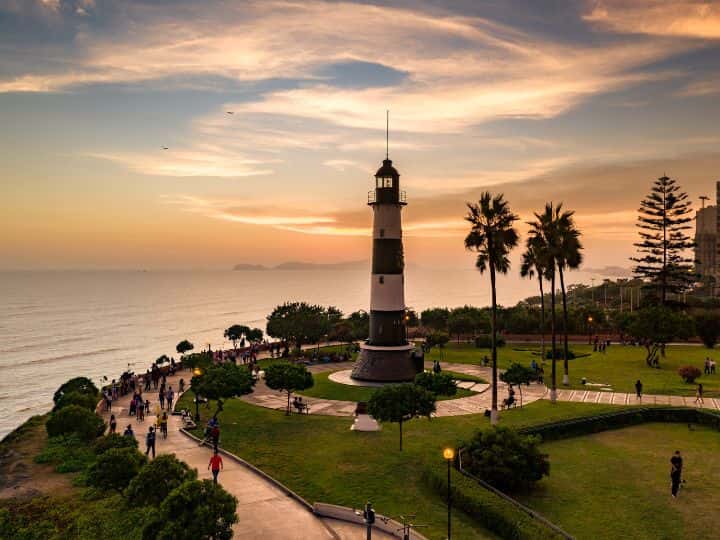
Miraflores at Sunset / 12 Days in Peru Itinerary
GOOD TO KNOW: Miraflores boasts a diverse culinary scene, offering a wide range of restaurants and eateries catering to various tastes and budgets. Indulge in a traditional Peruvian dinner at one of the many renowned cevicherias or savor international cuisine from around the world.
Miraflores comes alive after dark with a bustling nightlife scene. Whether you prefer trendy bars, dance clubs, or live music venues, you’ll find plenty of options to enjoy the evening’s entertainment.
PRO TIP: If you are up to it, visit the Magic Water Circuit, located a short distance from Miraflores. This enchanting park features 13 illuminated water fountains, synchronized with music and lights, creating a dazzling spectacle. The park’s highlight is the largest fountain, which shoots water up to 80 meters high.
Day 10 - Lima's Exploration: Rich Heritage and Cultural Marvels
Lima Exploration
- Historic Center of Lima: Plaza de Armas, Lima Cathedral, and the Presidential Palace, the San Francisco Monastery
- The Vibrant Neighborhood of Barranco
- Larco Museum
- Huaca Pucllana
Welcome to Day 10 of your Peruvian journey – Lima’s Rich Heritage and Cultural Marvels!
Today, you’ll dive deep into the heart of Peru’s capital city, Lima, exploring its historical treasures, vibrant neighborhoods, and ancient archaeological sites. From the grandeur of the Historic Center with its iconic Plaza de Armas, Lima Cathedral, and the Presidential Palace, to the bohemian charm of Barranco, this day promises a captivating mix of history, art, and culture.
Your exploration will take you to the renowned Larco Museum, where ancient artifacts and pre-Columbian wonders await, and to the enigmatic Huaca Pucllana, an ancient pyramid that holds secrets from Lima’s pre-Inca past.
Get ready to be enthralled by Lima’s rich heritage and immerse yourself in the marvels of this diverse and dynamic city. Let’s embark on this extraordinary adventure!
Historic Center of Lima: Plaza de Armas, Lima Cathedral, and the Presidential Palace, the San Francisco Monastery
Welcome to the Historic Center of Lima, where history and architectural marvels converge in the iconic Plaza de Armas, also known as the Plaza Mayor. Designated as a UNESCO World Heritage site, this historic square is flanked by significant buildings, including the Government Palace, the Archbishop’s Palace, and the Municipal Palace.
Marvel at the exquisite Spanish Baroque design of Lima Cathedral, which houses the tomb of Francisco Pizarro, the Spanish conquistador who founded Lima.
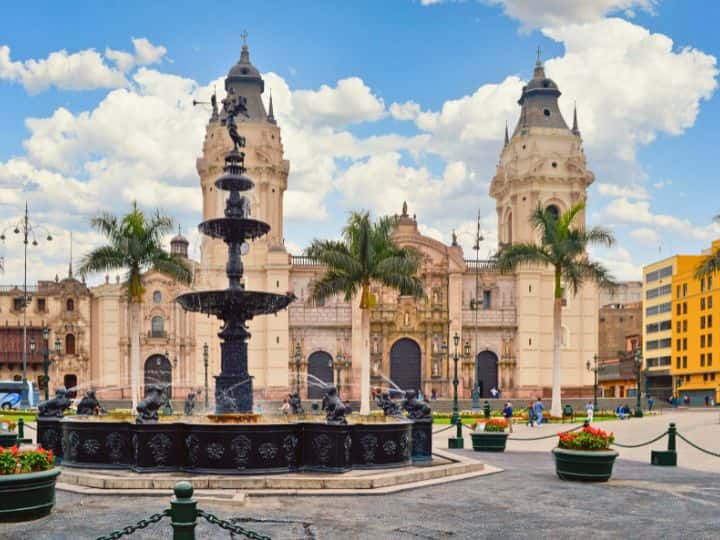
Lima Cathedral / 12 Days in Peru Itinerary
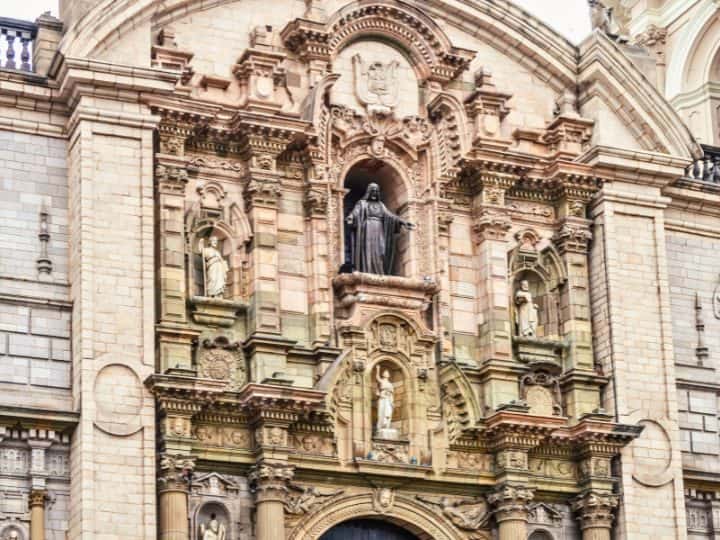
Lima Cathedral / 12 Days in Peru Itinerary
Get a glimpse of Peru’s political center as you visit the Presidential Palace, where the changing of the guard ceremony takes place daily at noon.
Lastly, venture into the San Francisco Monastery, a religious complex that holds an intriguing secret within its catacombs, entombing the remains of an estimated 70,000 people.
The Vibrant Neighborhood of Barranco
Discover the vibrant and artistic neighborhood of Barranco, where creativity and romance intertwine.
Stroll along the enchanting Bajada de los Baños, a charming walkway that leads you to Barranco, offering breathtaking views of the cliffs and the Pacific Ocean.
Immerse yourself in the bohemian ambiance as you explore the district’s thriving art scene, drawing in local and international artists, musicians, and writers.
Do not miss the iconic Puente de los Suspiros, the Bridge of Sighs, a romantic wooden bridge surrounded by legends and tales of love.
Larco Museum
Step into the captivating world of the Larco Museum, a treasure trove of pre-Columbian wonders that unveil the rich heritage of ancient Peru.
With over 45,000 artifacts on display, including ceramics, textiles, metalwork, and jewelry, the museum offers a fascinating glimpse into the diverse cultures that thrived in ancient times.
Prepare to be intrigued by one of its most captivating highlights – the collection of Moche erotic pottery, featuring intricate and explicit depictions of human sexuality, a testament to the artistic and symbolic expressions of ancient cultures.
Amidst the historical marvels, the Larco Museum is nestled within enchanting gardens, providing a tranquil and picturesque ambiance for exploration.
Huaca Pucllana
Unveil the mysteries of Huaca Pucllana, an extraordinary pre-Inca ruin nestled within the bustling modern neighborhood of Miraflores.
This ancient adobe and clay pyramid, dating back to around 500 AD, served as a significant ceremonial and administrative center for the Lima culture.
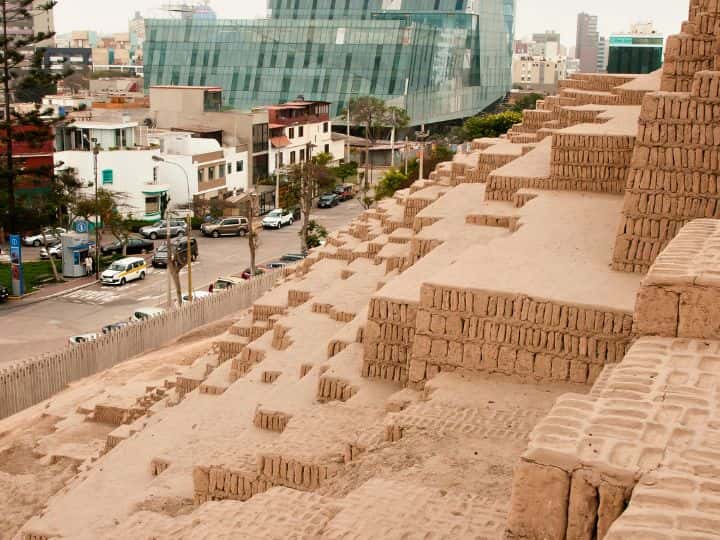
Huaca Pucllana / 12 Days in Peru Itinerary
Embark on guided tours to delve into its rich history and gain fascinating insights into the daily life of its ancient inhabitants.
As twilight descends, the site transforms into an enchanting spectacle, beautifully illuminated at night, creating a captivating contrast with the surrounding contemporary landscape of Miraflores.
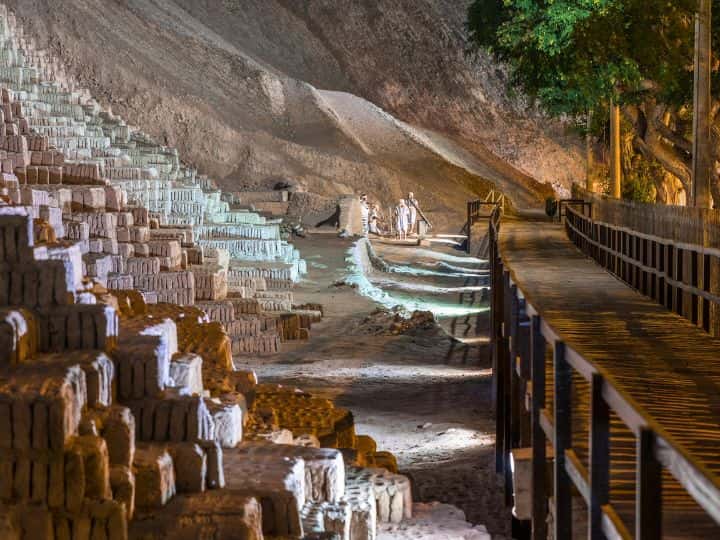
Huaca Pucllana at Night / 12 Days in Peru Itinerary
Day 11 - Day Trip from Lima to Lake Titicaca - The Islands of Uros and Taquile Island
- Journey from Lima to Lake Titicaca
- The Islands of Uros
- Taqulle Island
- Journey Back to Lima
Today, you will explore the wonders of Lake Titicaca!
Lake Titicaca is one of Peru’s most enchanting destinations, boasting a collection of unique distinctions that draw travelers from around the world. Perched at a high altitude of 3,812 meters (12,507 feet), it ranks as one of the highest navigable lakes globally, providing an ethereal setting amidst the Andean heights.
But Lake Titicaca is more than just a natural wonder; it holds profound cultural and spiritual significance. To the indigenous people of the Andean region, the lake is mythical, believed to be the birthplace of Inca royalty. Ancient rituals and ceremonies continue to be practiced on its shores, preserving the lake’s sacred legacy.
Journey from Lima to Lake Titicaca
How to Get to Lake Titicaca from Lima:
- The most convenient and direct option to reach Lake Titicaca is to fly from Lima to Juliaca. Juliaca is the closest major city to Lake Titicaca and serves as the main gateway to the lake’s Peruvian side.
- Several airlines operate flights from Lima’s Jorge Chávez International Airport to Inca Manco Cápac International Airport in Juliaca. The flight duration is approximately 1.5 hours, making it the fastest way to reach the region.
- From Juliaca, it is just a short drive of about 1 hour to reach Puno, the city located on the shores of Lake Titicaca. In Puno, you can easily arrange tours to explore the various islands and attractions of Lake Titicaca, such as the Floating Islands of Uros, Taquile Island, and Amantani Island.
- Here are two tours that include the Islands of Uros and Taquile Island: Uros and Taquile Islands on SpeedBoat and Uros Reed Floating Islands & Taquile Island Titicaca Puno Full Day
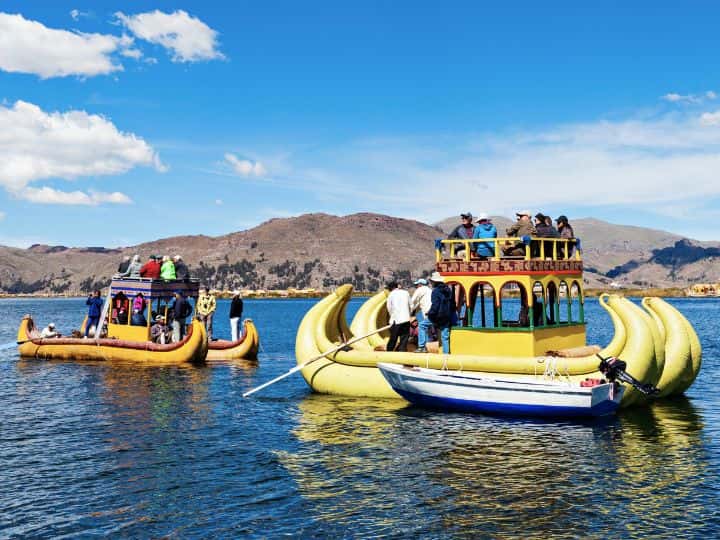
Tours on Lake Titicaca / 12 Days in Peru Itinerary
The Islands of Uros
The Floating Islands of Uros on Lake Titicaca are a fascinating testament to human ingenuity and adaptability.
These man-made islands are constructed entirely from layers of totora reeds, which grow abundantly in the lake’s shallow waters. The totora reeds serve as the foundation, and new layers are added periodically to maintain the island’s structure.
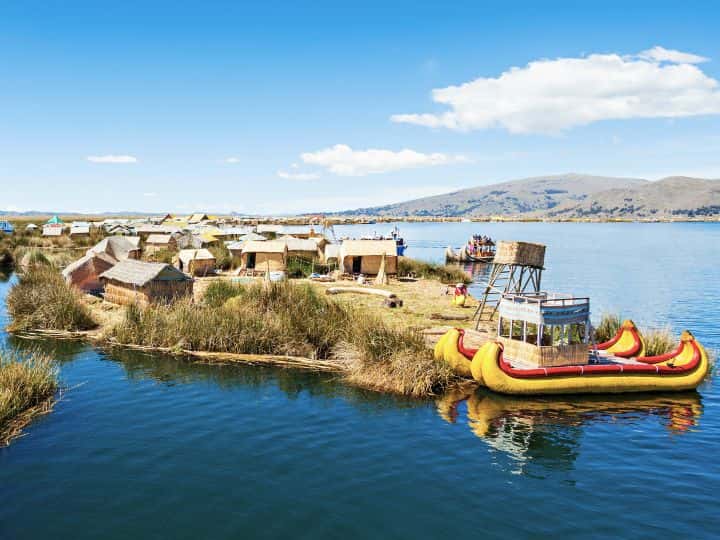
Floating Islands of Uros / 12 Days in Peru Itinerary
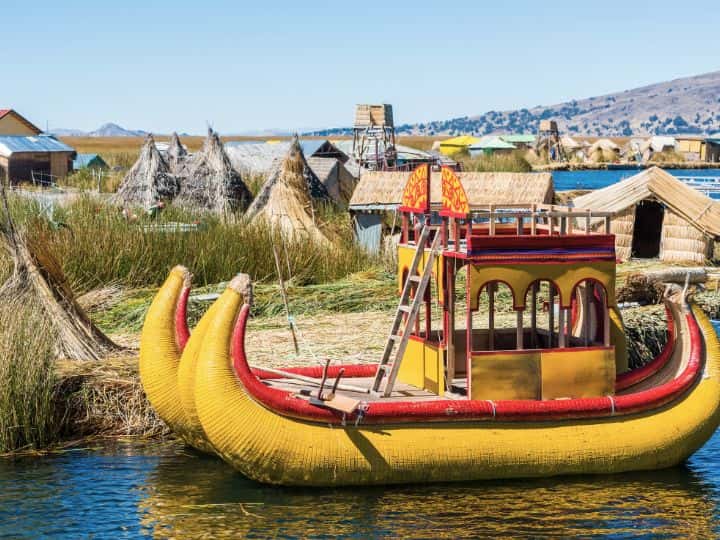
Floating Islands of Uros / 12 Days in Peru Itinerary
The Uros people, an indigenous community that has inhabited the lake region for centuries, are the architects and custodians of these unique islands. They have mastered the art of creating and sustaining these floating marvels, passing down the knowledge from one generation to the next.
Living on these islands allows the Uros people to be in harmony with the natural environment and the ever-changing water levels of Lake Titicaca. The reeds provide a buoyant foundation, keeping the islands afloat and enabling them to be moved if needed.
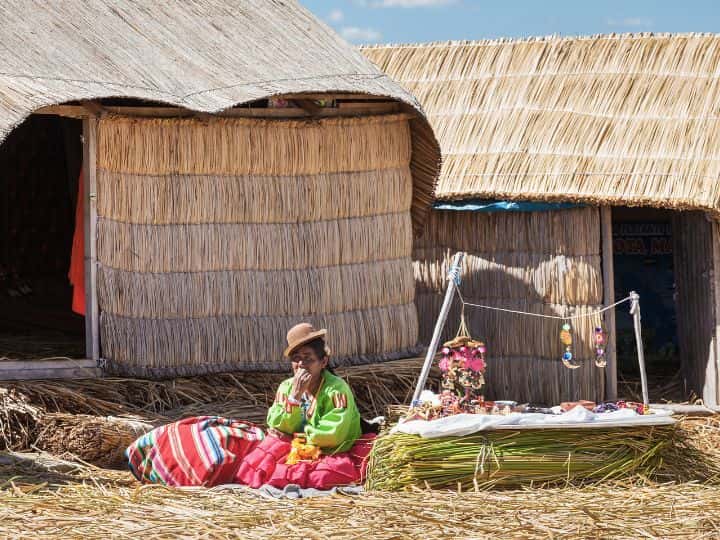
Floating Islands of Uros / 12 Days in Peru Itinerary
The Uros people’s traditional lifestyle revolves around fishing and handicrafts, activities that are intricately tied to the lake’s resources. Fishing provides sustenance and livelihood for the community, while handicrafts, made from totora reeds, are a means of income and trade with nearby communities.
Visiting the Floating Islands offers a unique opportunity to learn about the Uros people’s rich cultural heritage and way of life. Interact with the locals, who warmly welcome visitors to their floating homes, and gain insight into their customs, traditions, and daily routines.
Taquile Island
Taquile Island, nestled in the serene waters of Lake Titicaca, is a captivating destination that holds a treasure trove of cultural heritage and artistic expression.
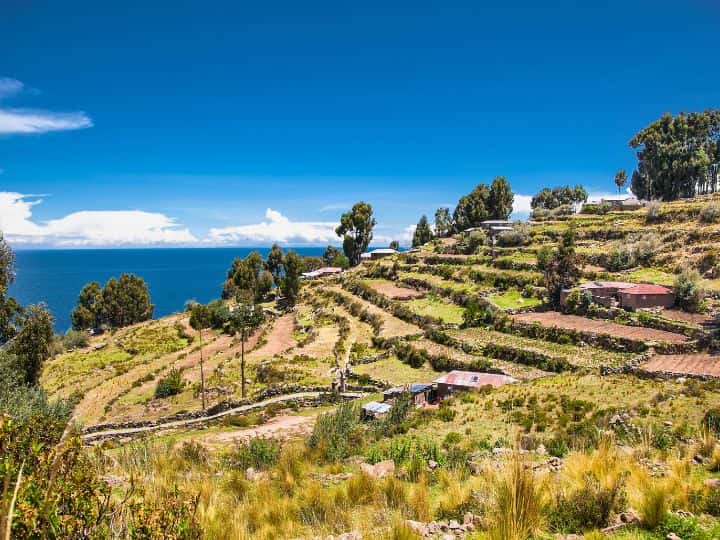
Taquile Island / 12 Days in Peru Itinerary
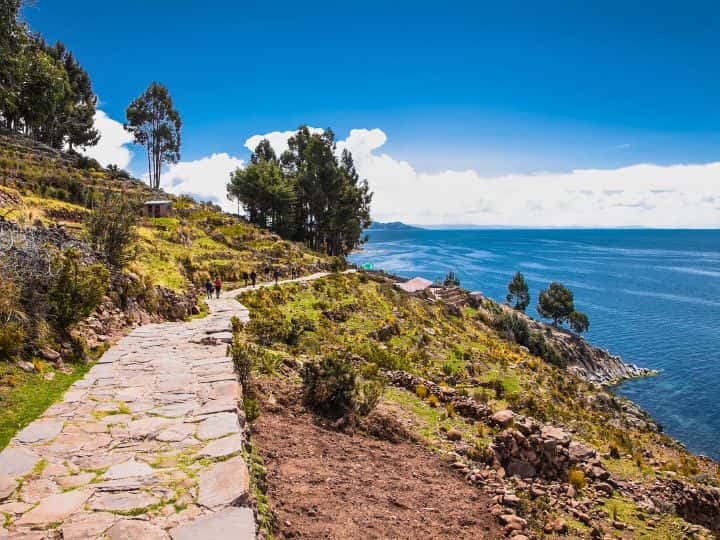
Taquile Island / 12 Days in Peru Itinerary
The island is renowned for its distinct textile traditions, which have been cherished and preserved by the local community for generations.
The art of weaving is deeply ingrained in the fabric of Taquile’s society, and it plays a central role in the islanders’ daily lives. Each piece of textile crafted here is a labor of love and a manifestation of the island’s vibrant cultural identity. The weavings are not merely decorations but carry profound meaning, symbolizing the islanders’ history, beliefs, and social hierarchy.
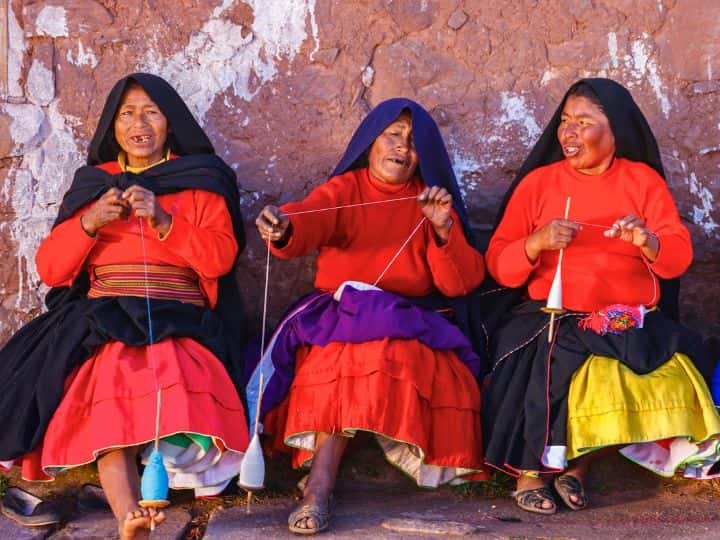
Taquile Island / 12 Days in Peru Itinerary
Unique to Taquile Island is the practice of weaving by men, which is an extraordinary and rare tradition in Andean cultures. On the island, men begin learning the art of weaving from a young age and continue throughout their lives. The textiles they create often reflect their marital status, age, and achievements, making the art form an essential aspect of personal and communal expression.
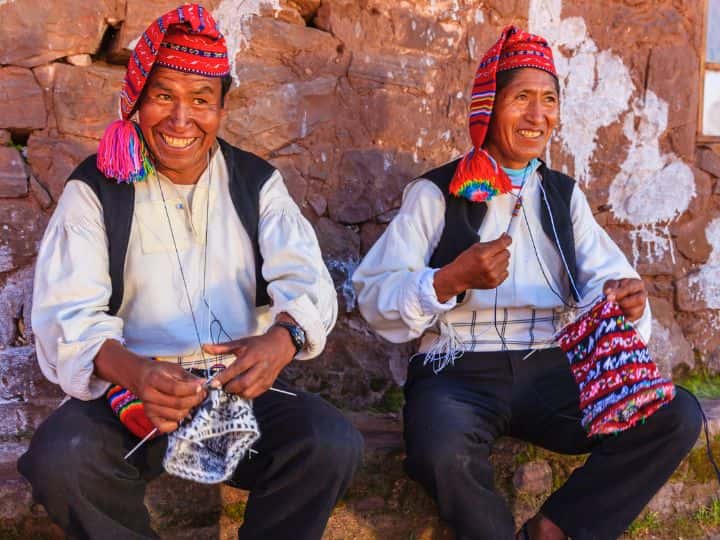
Taquile Island / 12 Days in Peru Itinerary
Journey Back to Lima
It is time to say goodbye to the enchanting Lake Titicaca and head back to Lima.
A short drive from Puno to Juliaca leads to your flight back to Lima, where the coastal capital awaits.
Reflect on the experiences and memories crafted on the mystical shores of Lake Titicaca, and cherish the cultural encounters and breathtaking landscapes that have left an indelible mark on your heart!
Day 12 - Day Trip from Lima to the Nazca Lines, Chauchilla Cemetery, Antonini Archaeological Museum
- Flight from Lima to Nazca
- Nazca Flight Tour
- Chauchilla Cemetery Tour
- Antonini Archaeological Museum
- Flight Back to Lima
Today, you will embark on an extraordinary adventure from Lima to unravel the mysteries of the Nazca Lines!
This enigmatic UNESCO World Heritage Site, located in the arid desert plains of southern Peru, holds captivating geometric and animal geoglyphs etched into the earth’s surface.
Flight from Lima to Nazca
PRO TIP: Take an early morning flight from Lima to Nazca. The flight usually lasts around 1.5 hours.
From my personal experience, the flights are inexpensive and they are a much better alternative than driving or taking a bus. If you decide to drive, then be prepared to be on the road for at least 6 hours before reaching Nazca.
Nazca Flight Tour
The Nazca Lines are located in the Nazca Desert, a barren plateau in southern Peru. The desert spans the Pampas de Jumana, an arid region approximately 400 kilometers (250 miles) south of Lima.
The Nazca Lines cover an area of about 450 square kilometers (174 square miles) and are best viewed from the air.
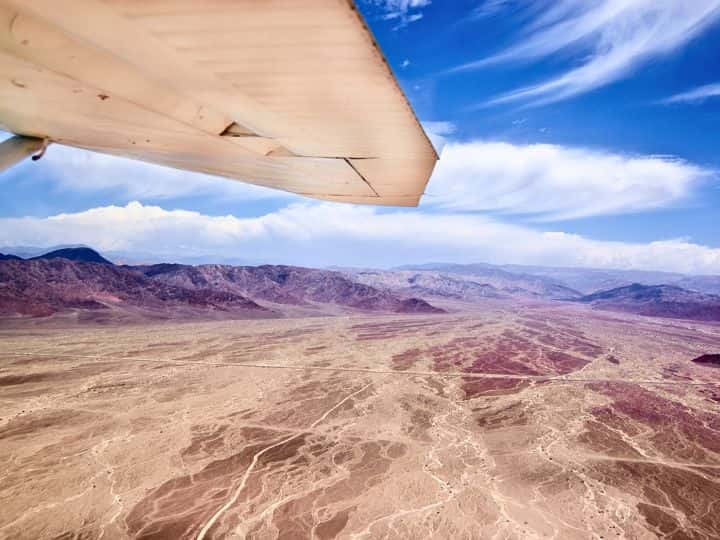
Flight Over Nazca Lines / 12 Days in Peru Itinerary
The Nazca Lines are a series of enormous and intricate geoglyphs. These enigmatic figures include geometric shapes, animals, plants, and human-like forms, with some measuring up to 1,200 feet (370 meters) in length. Their creation dates back to between 500 BCE and 500 CE, during the Nazca culture’s zenith.
The sheer scale and precision of the lines have puzzled archaeologists, as the Nazca people lacked access to aerial perspectives. Theories regarding their purpose range from astronomical calendars and irrigation systems to religious or ceremonial significance. Their preservation over the centuries is attributed to the region’s arid climate, with the designs etched into the desert floor.
To see the Nazca Lines, you need to take a flight over the Nazca Lines. The flight provides a unique perspective that lets you appreciate the large-scale geoglyphs etched into the desert floor.
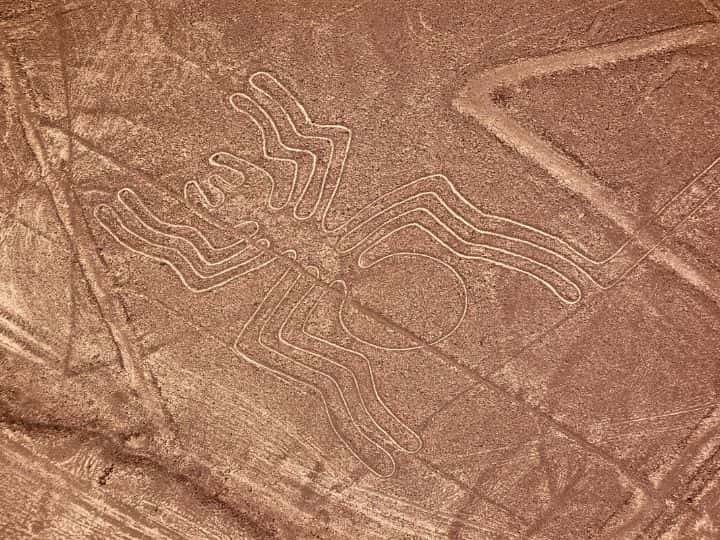
Nazca Lines / 12 Days in Peru Itinerary
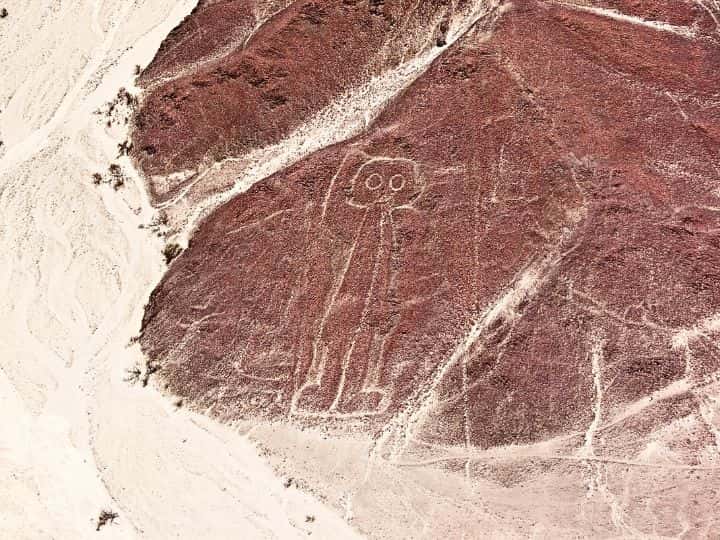
Nazca Lines / 12 Days in Peru Itinerary
PRO TIP: Check out this 1-hour sightseeing flight over the famous Nazca Lines and over the more recently discovered Palpa Lines: Nasca and Palpa Lines Flight. I enjoyed the long flight and appreciated an excellent commentary!
Chauchilla Cemetery Tour
Next on today’s itinerary are Chauchilla Cemetery and the Antonini Archaeological Museum.
PRO TIP: To visit Chauchilla Cemetery and the Antonini Archaeological Museum, you can take a guided tour from the town of Nazca or hire a private guide/car. The journey to the cemetery and museum involves a short drive through the desert, allowing you to appreciate the arid beauty of the Nazca region.
Chauchilla Cemetery is an extraordinary archaeological site. It is a burial ground that provides a rare and haunting glimpse into the funerary practices of the ancient Nazca civilization. The cemetery dates back over a thousand years and offers a unique opportunity to observe remarkably well-preserved mummies and artifacts from this pre-Inca culture.
Here is what you need to know:
- The main attraction at Chauchilla Cemetery is the collection of mummies that lie in open tombs. These mummies are remarkably well-preserved due to the arid climate of the Nazca Desert. They were buried in a seated position, wrapped in layers of cloth, and adorned with various textiles, jewelry, and pottery.
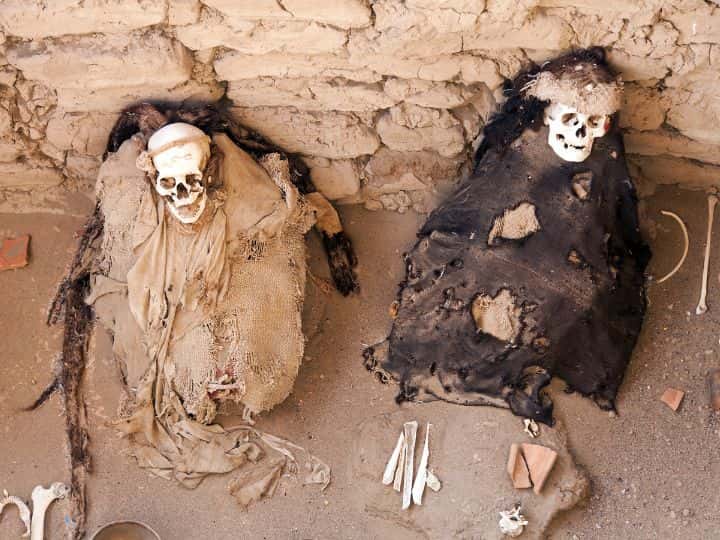
Chauchilla Cemetery / 12 Days in Peru Itinerary
- Alongside the mummies, you will find a rich assortment of grave goods and artifacts. The Nazca people believed in an afterlife and, therefore, buried the deceased with items they might need in the next world. These include pottery vessels, textiles, tools, and personal ornaments. The artifacts offer valuable insights into the culture’s daily life, religious beliefs, and artistic skills.
- Chauchilla Cemetery has survived remarkably well over the centuries due to the extremely dry climate of the region. The dry conditions have protected the mummies and their grave goods, making it a unique site for archaeologists to study and understand ancient burial practices.
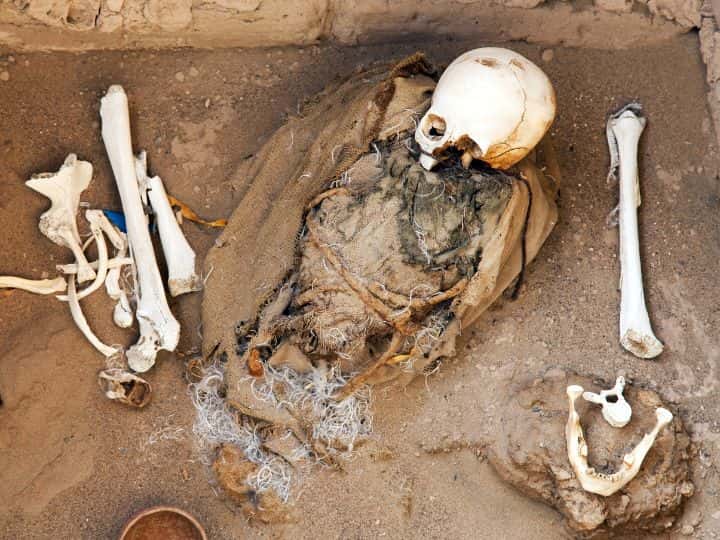
Chauchilla Cemetery / 12 Days in Peru Itinerary
- The site’s exploration has provided valuable information about the Nazca civilization and its burial rituals. Archaeologists have been able to gain insights into the Nazca’s burial traditions, social structures, and belief systems through their discoveries at Chauchilla Cemetery.
The Antonini Archaeological Museum
The Antonini Archaeological Museum, also known as the Museo Antonini, is a fascinating institution located in Nazca. The museum is dedicated to showcasing and preserving the cultural heritage of the Nazca civilization, one of the ancient pre-Inca cultures that thrived in the region:
- Nazca Culture Exhibits: The museum houses an impressive collection of artifacts, ceramics, textiles, and other archaeological finds from the Nazca culture. These exhibits offer visitors a comprehensive understanding of the civilization’s daily life, religious beliefs, artistic expressions, and technological achievements.
- Nazca Pottery and Textiles: One of the highlights of the museum is its display of intricate Nazca pottery and textiles. The Nazca were renowned for their exceptional pottery craftsmanship, and the museum showcases a diverse range of pottery vessels decorated with elaborate designs and motifs. The textiles on display offer insights into the Nazca people’s weaving techniques and patterns.
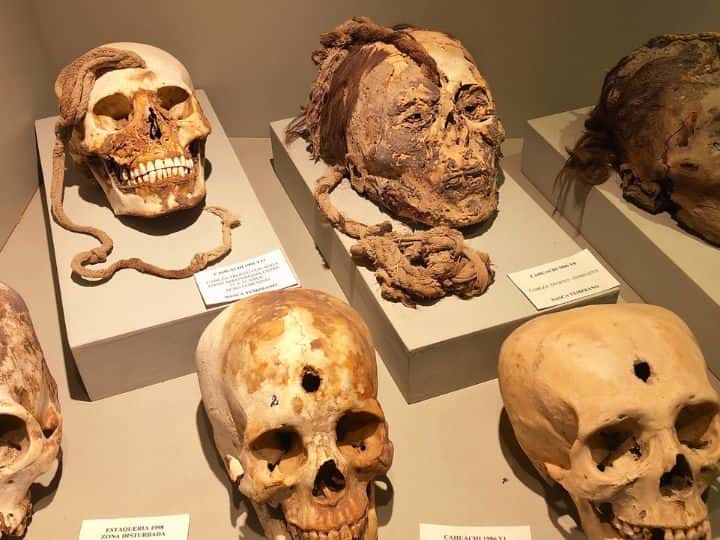
The Antonini Archaeological Museum / 12 Days in Peru Itinerary
- Mummies and Funerary Artifacts: The Antonini Museum also features exhibits related to funerary practices of the Nazca culture. You can find mummy bundles, grave goods, and other artifacts associated with burial rituals. These displays provide valuable insights into how the Nazca people honored their deceased and their beliefs in the afterlife.
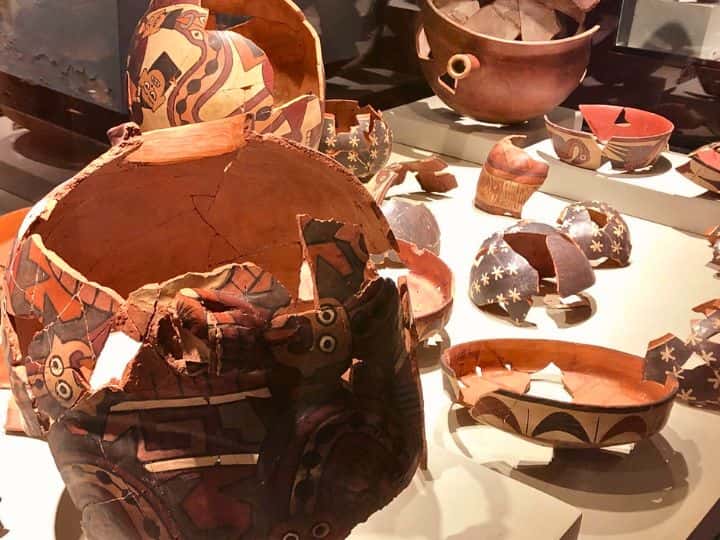
The Antonini Archaeological Museum / 12 Days in Peru Itinerary
- Aqueducts and Irrigation: The museum highlights the Nazca civilization’s innovative irrigation systems, which allowed them to thrive in the arid desert landscape. The ancient Nazca people constructed sophisticated underground aqueducts that provided water for agricultural purposes, contributing to their ability to cultivate crops and sustain their society.
- Nazca Lines Information: The Antonini Museum also offers information and explanations about the Nazca Lines, a nearby UNESCO World Heritage Site. Visitors can learn about the different geoglyphs, their possible significance, and the ongoing research and conservation efforts dedicated to preserving these ancient wonders.
Intrepid Scout's Tips for 12 Days in Peru Itinerary
- Embarking on a 12-day journey through Peru is an adventure of a lifetime, a tapestry woven with ancient wonders, vibrant cultures, and breathtaking landscapes. From the mystical ruins of Machu Picchu to the enigmatic Nazca Lines, every destination offers a glimpse into the country’s rich heritage.
- Embrace the spirit of exploration as you wander through the colonial streets of Cusco, marvel at the precision of Incan stonework, and immerse yourself in the lively markets brimming with colorful handicrafts. Traverse the sacred valley, discover the mysteries of ancient fortresses, and witness the awe-inspiring beauty of the Amazon rainforest.
- Throughout your travels, savor the flavors of Peruvian cuisine, indulge in the warmth of its people, and cherish the memories of each unique experience. Be open to embracing the unknown and uncovering the hidden gems that make Peru an unforgettable destination.
Bon voyage, and may your journey through Peru be one filled with wonder, learning, and cherished moments that will stay with you forever.
Safe travels and happy exploring!
You Might Also Like:
BEST TIME to VISIT MACHU PICCHU (Top #1 Month for Ultimate Adventure)
Best SELF-GUIDED MACHU PICCHU TOUR (Explore 11 Marvels of Inca Citadel)
How to See the Mesmerizing SUNRISE at MACHU PICCHU (9 Steps to Witness the Magic)
9 Best PHOTOGRAPHY LOCATIONS at MACHU PICCHU (+Useful Photo Tips)
9 Top THINGS to DO at MACHU PICCHU (Unveiling the Enchanted City of the Incas)
How to Reach Machu Picchu Without Hiking (2 Easy Steps!)
Hiking to MACHU PICCHU from AGUAS CALIENTES in 4 Easy Steps
7 Fun and Cool THINGS to DO in AGUAS CALIENTES (Besides Machu Picchu)
Cusco to Maras Salt Mines: 6 Things to Discover in Sacred Valley’s Natural Wonder
3-Day Adventure in the Amazon, Peru: Discover the Untamed Rainforest
Did You Find This Useful?
Why Not Save 12 Days in Peru Itinerary to Your Pinterest Board!
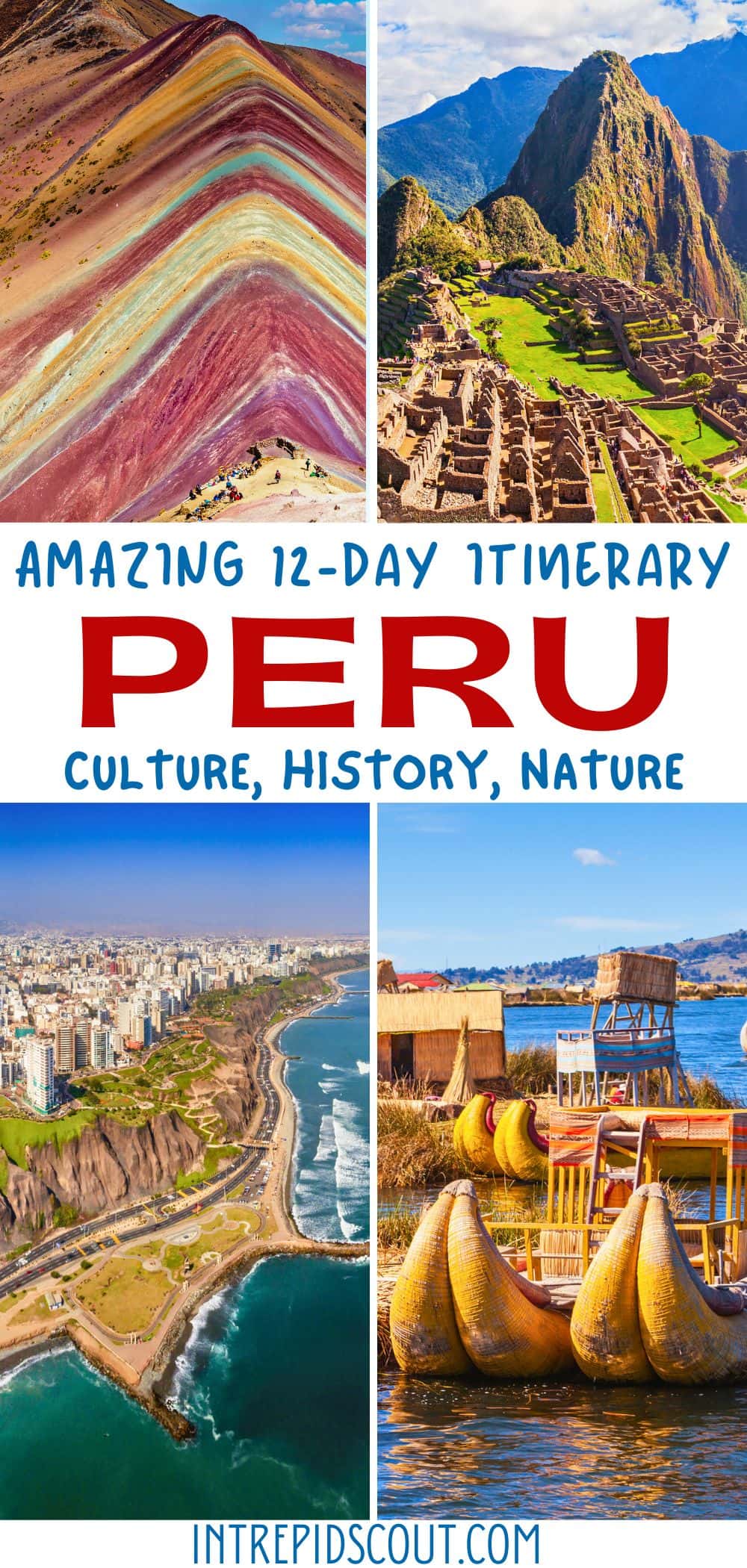
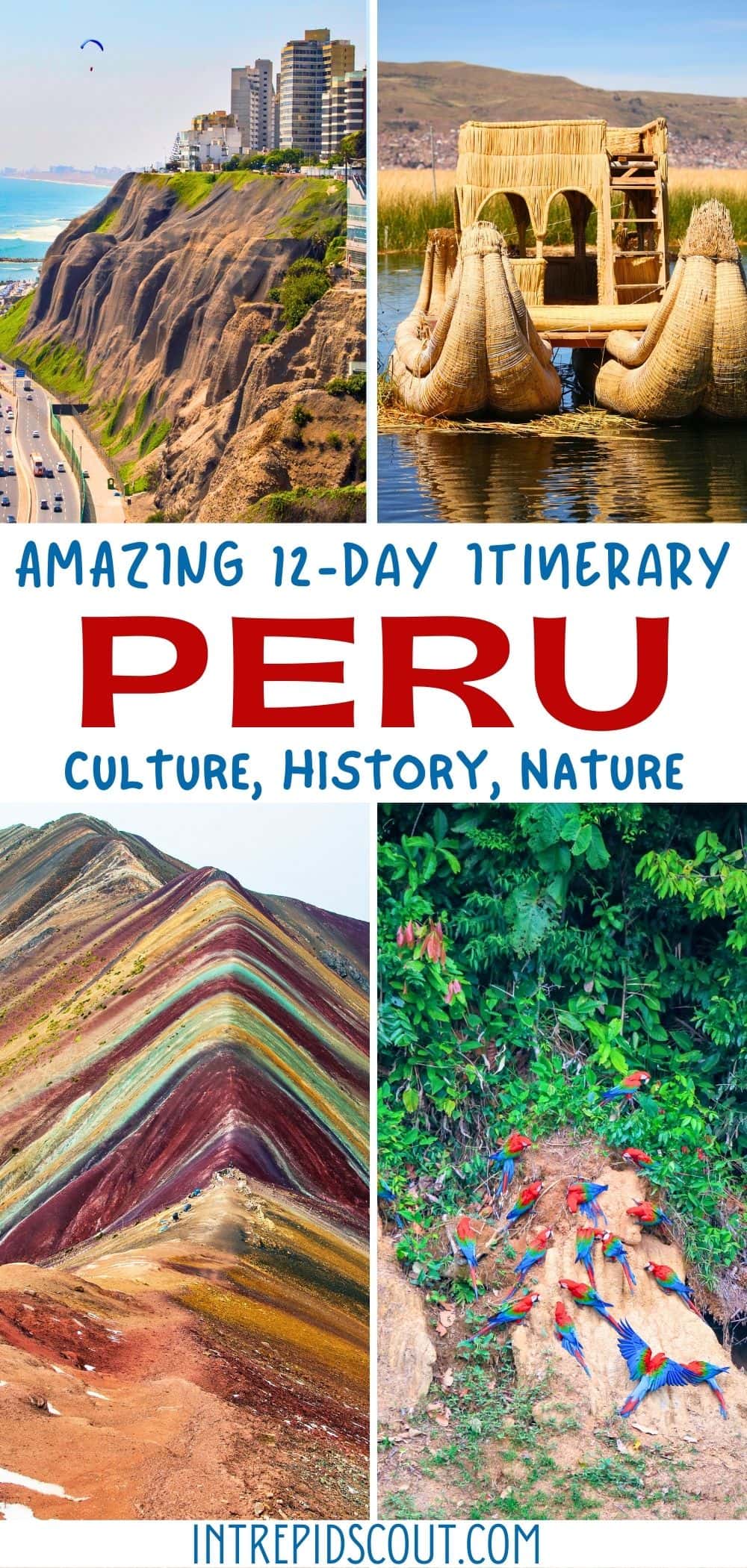
Now, It Is Your Turn, I Would Like to Hear Back from You!
Are you planning a trip to Peru?
Please let me know! Drop me a quick comment right below!
Click on any of the images below to get inspired and to help you with the planning process for your trip to Peru!
